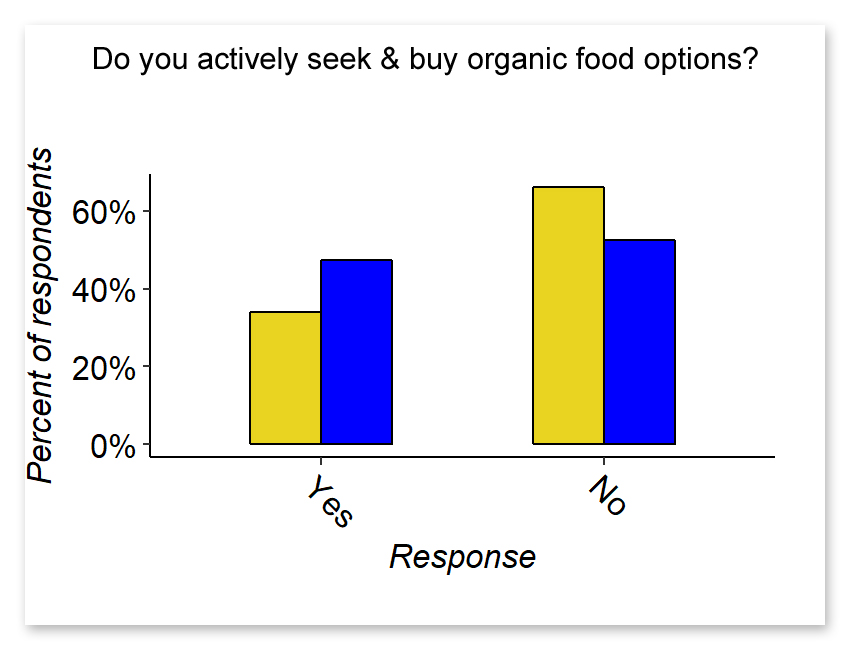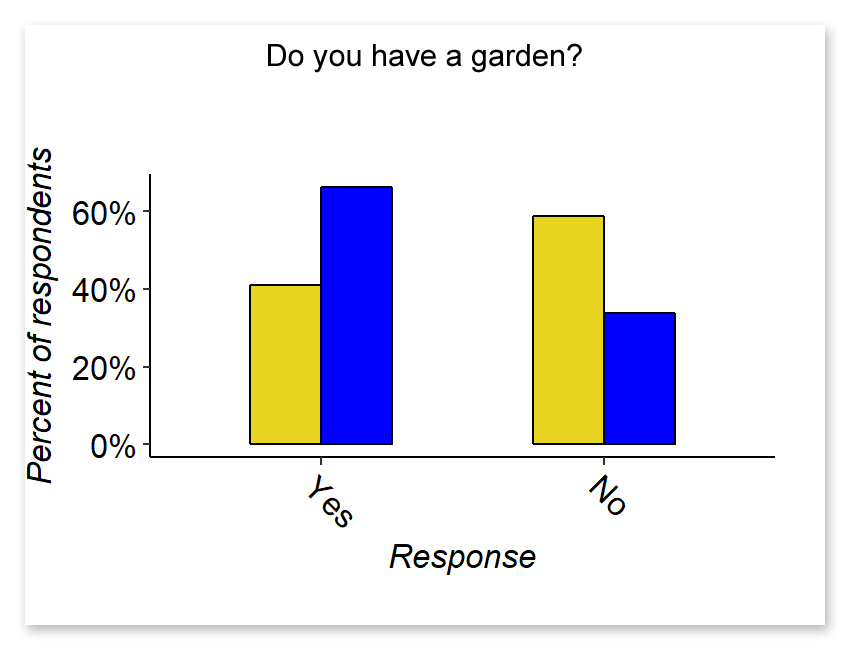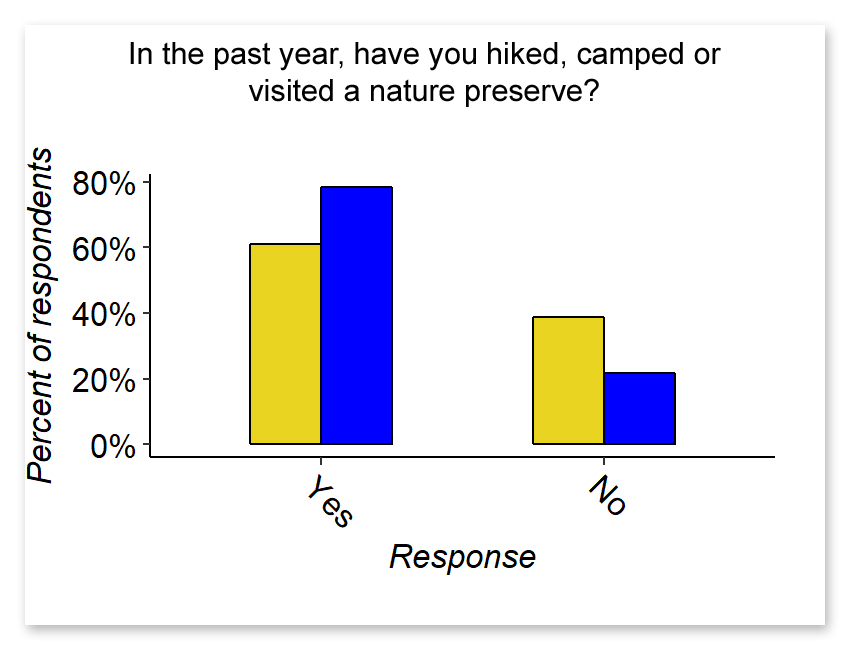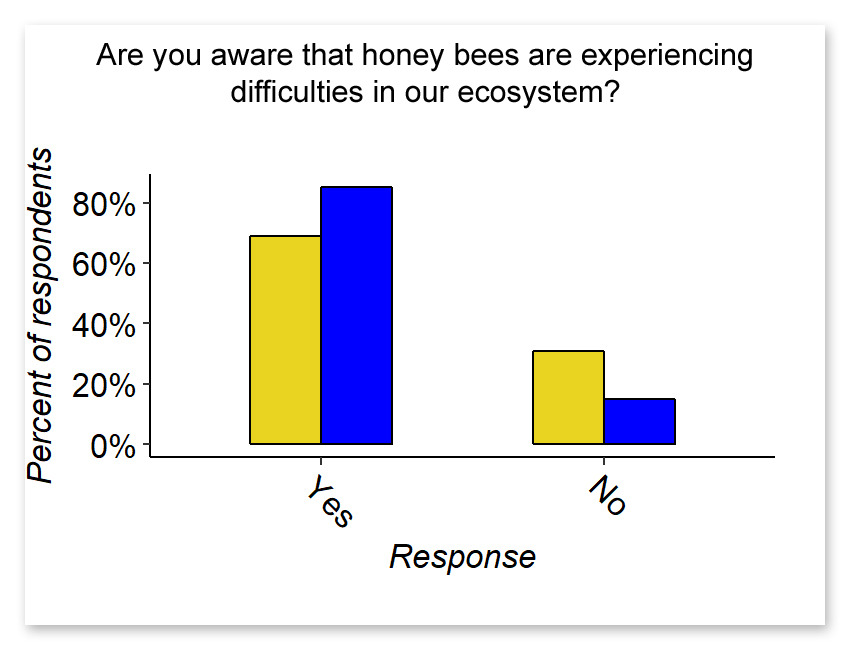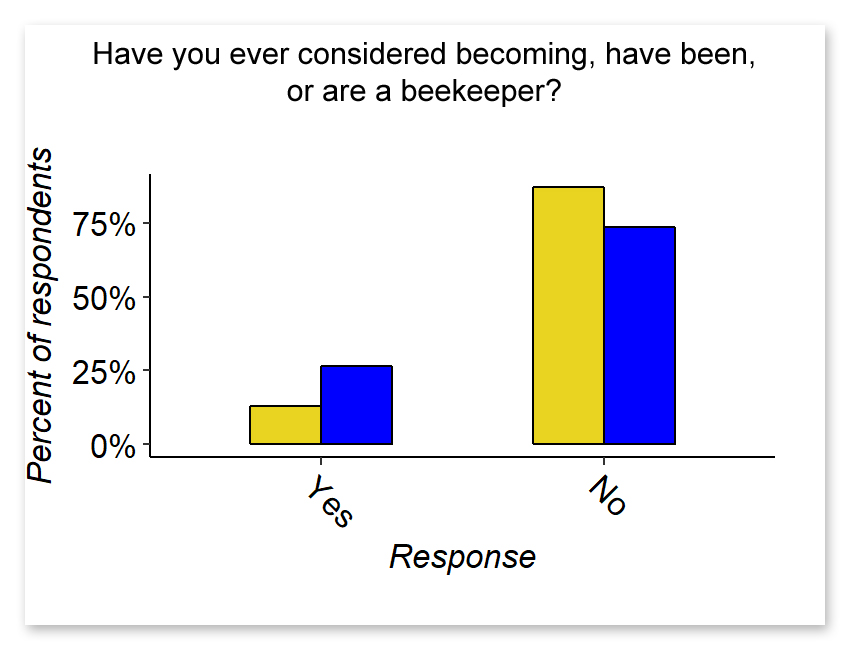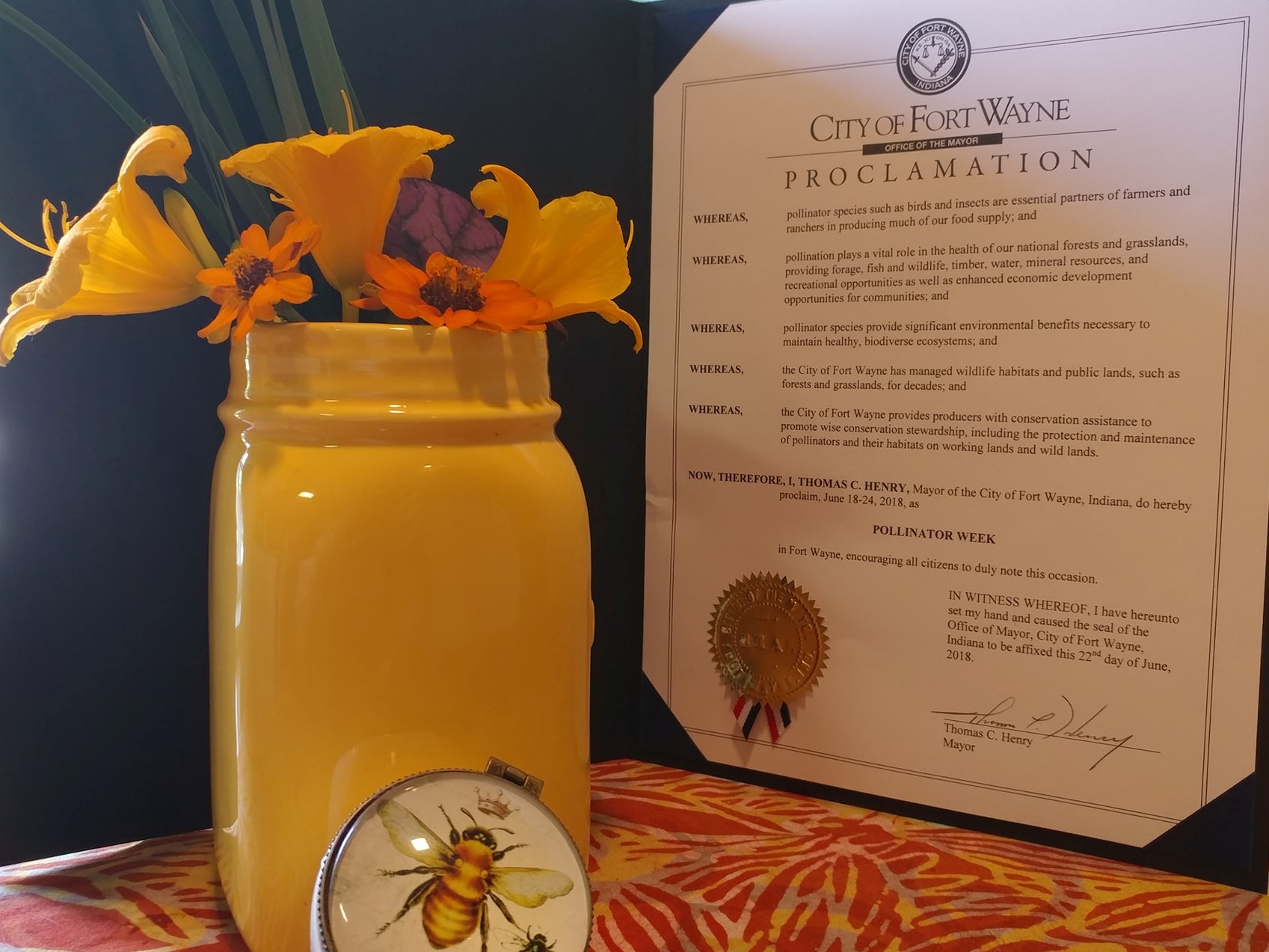Final report for FNC16-1054
Project Information
Southwest Honey Co. operates out of their home base at the Southwest Conservation Club in Fort Wayne, Indiana. Although Southwest Honey Co. manages hives in other preserved and natural areas of Fort Wayne and the surrounding area, the Southwest Conservation Club is home to the “Science Exploration Tent” where educational events are hosted. The Southwest Conservation Club consists of 37 acres of natural spring-fed ponds, hiking trails, a plethora of wildlife, and a prairie full of native Indiana wildflowers. Southwest Honey Co. manages over 50 hives, 8 of which are in apiaries at the Southwest Conservation Club.
Prior to receiving this grant, Southwest Honey Co. used practices of sustainable beekeeping and “bee friendly” options while caring for honey bees. These sustainable beekeeping practices consisted of actions such as allowing the bees to naturally interact with nature and only entering the hives when necessary, choosing organic options for varroa mite treatment rather than harsh chemicals, and putting honey production as a secondary priority after the health and well-being of the honey bees.
This study sought to evaluate any change between consumer choices in the Northeast Indiana area that would positively impact the honey bee populations after participating in an educational class. The study hypothesized that after learning about honey bees, how pollination assists with food production and actions participants can take to help curb their decline, consumers would cease some or all of their actions that negatively affect pollinators and make conscious choices that benefit pollinator populations.
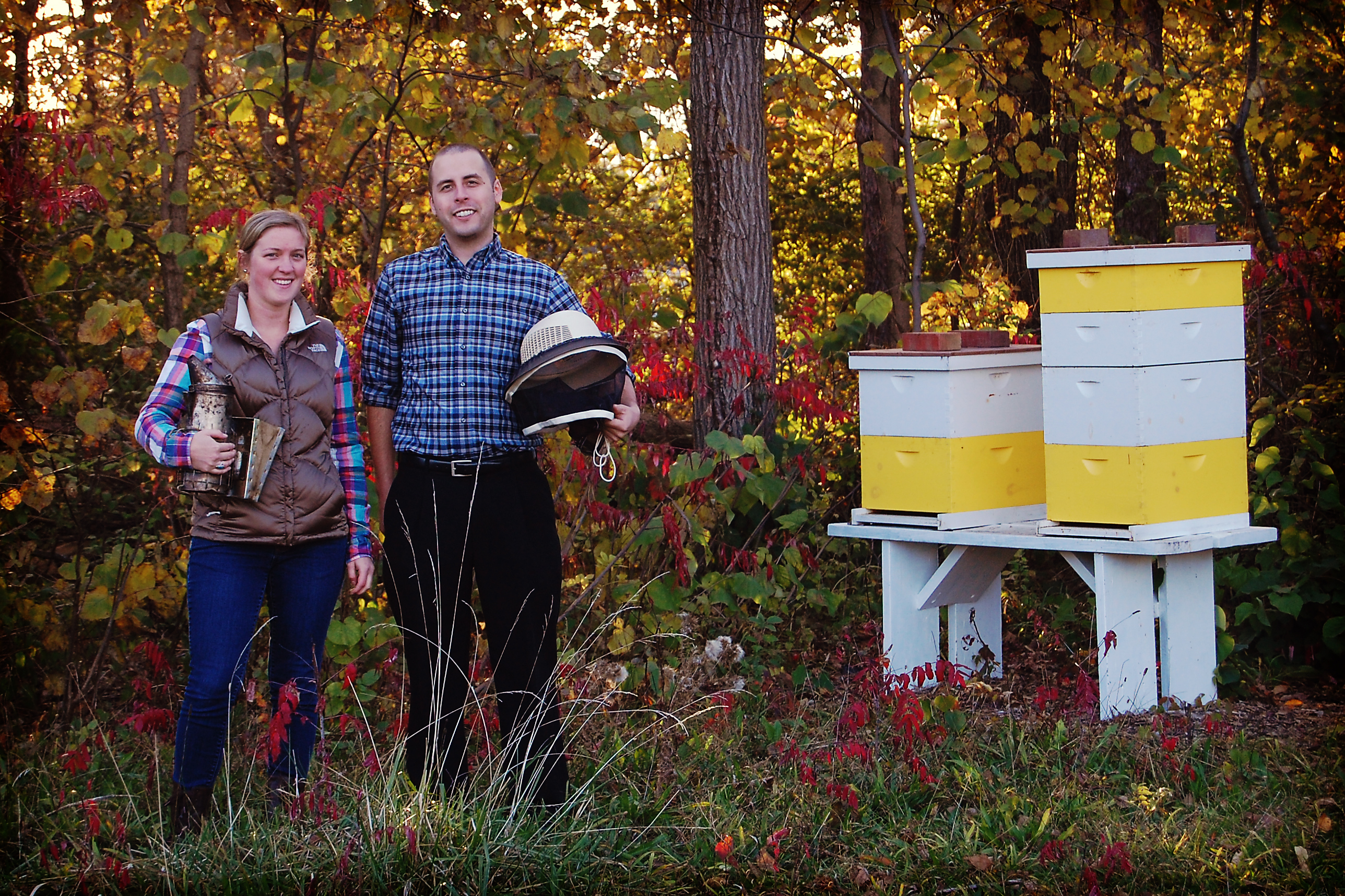
The overall problem hypostasized to be solved with this project is to assist declining honey bee populations. This project also addressed connected problems including the lack of regional opportunities for comprehensive pollinator education, awareness of honey bee population decline and awareness of actions consumers can take to benefit pollinators. The project also encouraged themes that challenged current ideals about the importance of land use and chemical treatment, local produce shopping, gardening, beekeeping, and outdoor and environmental appreciation.
All of the themes and topics taught or discovered inherently through the program were intended to be evaluated options or mind-sets to assist honey bee populations. However, although the program was focused on the honey bee, most pollinators would also benefit from steps taken by consumers.
The study evaluated adult participants via a series of surveys throughout the duration of their learning, including ‘pre-survey’ (before any educational influence), ‘post-survey’ (immediately after the completion of the class), and a ‘long-range survey' (6-8 months after the class). The surveys were provided to participants with consistent instruction, format and questions. They contained a variety of questions focused on the topics of the study consisting primarily of Likert scale and fill-in-the-blank questions to maintain comparative data. The surveys were designed to evaluate introductory knowledge of the topics and habits, then the participants’ intention of change, and finally any specific changes that actually occurred.

Conclusions
The educational programs were very well received by the public, attracting 2,194 participants of all ages from throughout the local area over the two-year study timeline. Comments from participants as well as parents of participants were very positive and appreciative that a program focusing on honey bees and pollinators exists as a resource for them to learn in an interactive format. Over 95% of participants rated the class the highest mark possible and the same number showed a need for similar pollinator education to be taught in school curriculums.
According to survey data, by-and-large, following the program participants showed a significant desire to change daily habits to benefit pollinators. Participants said they gained more knowledge about honey bees, placed a greater level of importance on the need for pollinators, rated the problems regarding bees as severe, and held a greater appreciation for pollinators in general.
Using the knowledge participants learned, they indicated that they wanted to take steps to help pollinators and reported that they left the class with a desire to buy more local, organic produce when shopping, including local honey. They said they planned to garden more and that they would be making special considerations to benefit pollinators, such as planting native flowers, and ceasing or reducing chemical lawn treatments. Participants also reported that they would be spending more time outside, hiking, camping or visiting a nature preserve, including volunteering for conservation organizations. They also shared that they had an interest in becoming a beekeeper.
However, according to survey data 6 to 8 months after the class, the many considerations that participants felt they wanted to make had yet to be implemented in most cases. The data showed that participants continued to feel that the severity of bee problems were high, and pollinators are important in general. Participants are now using more honey and actively seeking local honey. All other categories showed no sign of significant improvement.

The following are possible causes for the lack of implementation of desired changes:
- Surveys were sent in very early spring which may have led to less impactful results due to the time of the year.
- There is also the potential for a lack of resources being available, both material and informational resources.
- Some of the desired changes may be considered too costly for some participants.
- Due to human tendencies, it is also possible that participants were unable to break traditional habits.
- There may have been other personal reasons that impacted their decision to delay changes.
Whatever the cause for not yet implementing change, the data displays that participants continued to hold an awareness of what they could do to help pollinators and they desired to take steps to help them. However, implementation of these changes may take time and planning for the program participants.
Objectively, this project aimed to increase awareness and appreciation for the honey bee and the impact on agriculture and food sources. In order to address this current lack of awareness, the project consisted of providing the community with hands-on educational programs for children, adults, and seniors that focused on how the honey bees fit into the ecosystem, their impact on our food sources, and what consumers can do to help.
Cooperators
- (Educator)
- (Educator)
Research
The educational event portion of this study was designed to reach three different targeted age groups in the community (children, adults, and seniors) through a hands-on program with an interactive approach to learning about pollinators.
Topics covered included honey bees and their role in our ecosystem and how it connects to both the food we eat and our local growers, the roles of the worker bees, drone bees and queen bee in the hive, how honey bees communicate, the anatomy of the honey bee, the life cycle of the honey bee, observation and exploration skills, the importance of conservation, and why honey bees and pollinators are struggling, and what can be done to help.
Marketing, Advertising & PR
All marketing and promotions were coordinated with the expertise of a marketing coordinator in order to target each of the three populations. Outreach for the programs was accomplished through contacting conservation organizations, schools, libraries, home school communities, community centers, summer camps, and assisted living communities. Promotions also included advertising, press releases and interviews in traditional media, as well as promotional posts on social media and information on the organization’s website. Promotional flyers and information were provided to guests at speaking events and educational programs.
Educational Experiences
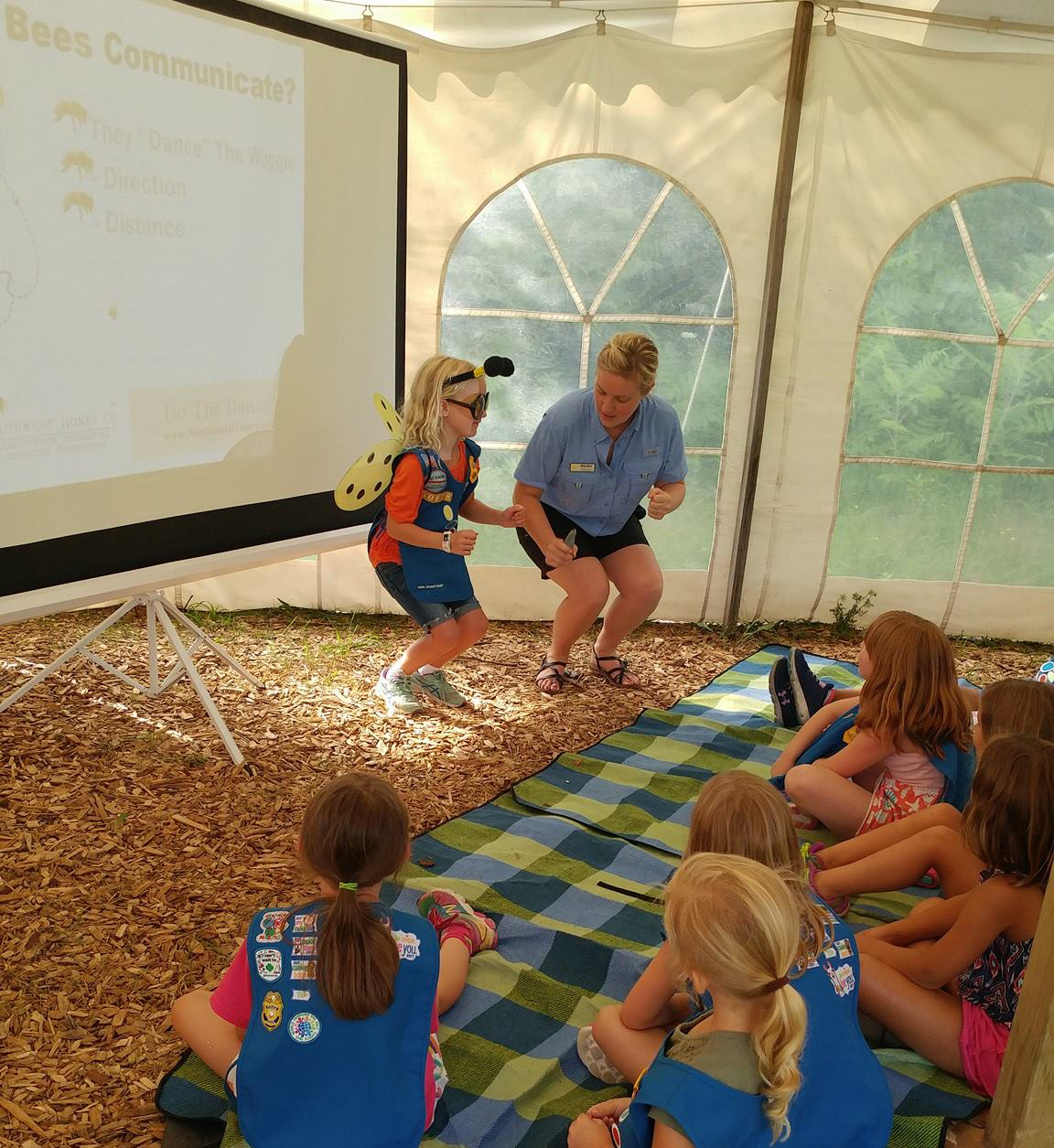 No matter the age group, each of the programs were designed to consistently cover the same key topics. However, the presentation of the educational material was formatted to fit the audience at hand. All of the programs began with a short presentation introducing the participants to honey bees through a set of power point slides covering topics such as: pollination, the daily life of the bees, the roles of the worker bee, queen bee, and drone bees in the hive, and the communication of honey bees through an interactive demonstration of the “Waggle Dance.”
No matter the age group, each of the programs were designed to consistently cover the same key topics. However, the presentation of the educational material was formatted to fit the audience at hand. All of the programs began with a short presentation introducing the participants to honey bees through a set of power point slides covering topics such as: pollination, the daily life of the bees, the roles of the worker bee, queen bee, and drone bees in the hive, and the communication of honey bees through an interactive demonstration of the “Waggle Dance.”
Following the introductory presentation, participants were then broken into groups to rotate through a series of hands-on Exploration Stations. Each of these stations targeted a different aspect of the honey bee, engaging all the senses and providing constant interaction and opportunities for learning. Each station was set up to allow students to move around the table and touch, smell, see, taste and experience all that was available for learning. On each table, students and parents also found guided question cards that were aimed to help learners continue their discovery and guide them in the right direction.
Following the rotation through the Exploration Stations, participants were brought back together to conclude the program with a discussion of what they learned. Through this discussion, participants were encouraged to brainstorm the possible reasons that honey bees and other pollinators might be struggling to survive in our current ecosystem. They were then asked to help generate a list of ideas of the ways they could assist the honey bees and make changes to their daily life to improve pollinator populations.
The entirety of these programs and curriculum was designed by an Education Program Director with a Master’s Degree in Education. All programs were designed for a maximum of 30 students at time. With a maximum of 30 students, this allowed for a more intimate program and gave students a more personal learning experience. This also allowed the teachers and volunteers to spend more time with each participant and help to answer all of their questions. The volunteers who assisted with programming were trained by the Education Program Director. This training encompassed a well-rounded scope of beekeeping including hive maintenance, the life cycle of bees and their roles as a hive-minded body, as well as honey extraction. This thorough and in-depth training gave the volunteers the ability to interact and educate the community with confidence and extensive knowledge.
What makes this study and program unique is not only the format, but also the message and goal behind it. Many existing pollinator or honey bee education courses focus on beekeeping and perhaps planting pollinator gardens. However, Southwest Honey Co.’s programs were designed to allow students to be active and utterly immersed in the learning; sometimes without even knowing it. When movement and laughter are integrated into learning, the impact is great. Students who are given a chance to explore and learn using all their senses are more highly engaged in the information they are taking in. With less of a focus on beekeeping, and more of a focus on awareness and connecting participants with honey bees and how they relate to our ecosystem and the food we eat, the impact was much greater.
Age Specific Programs
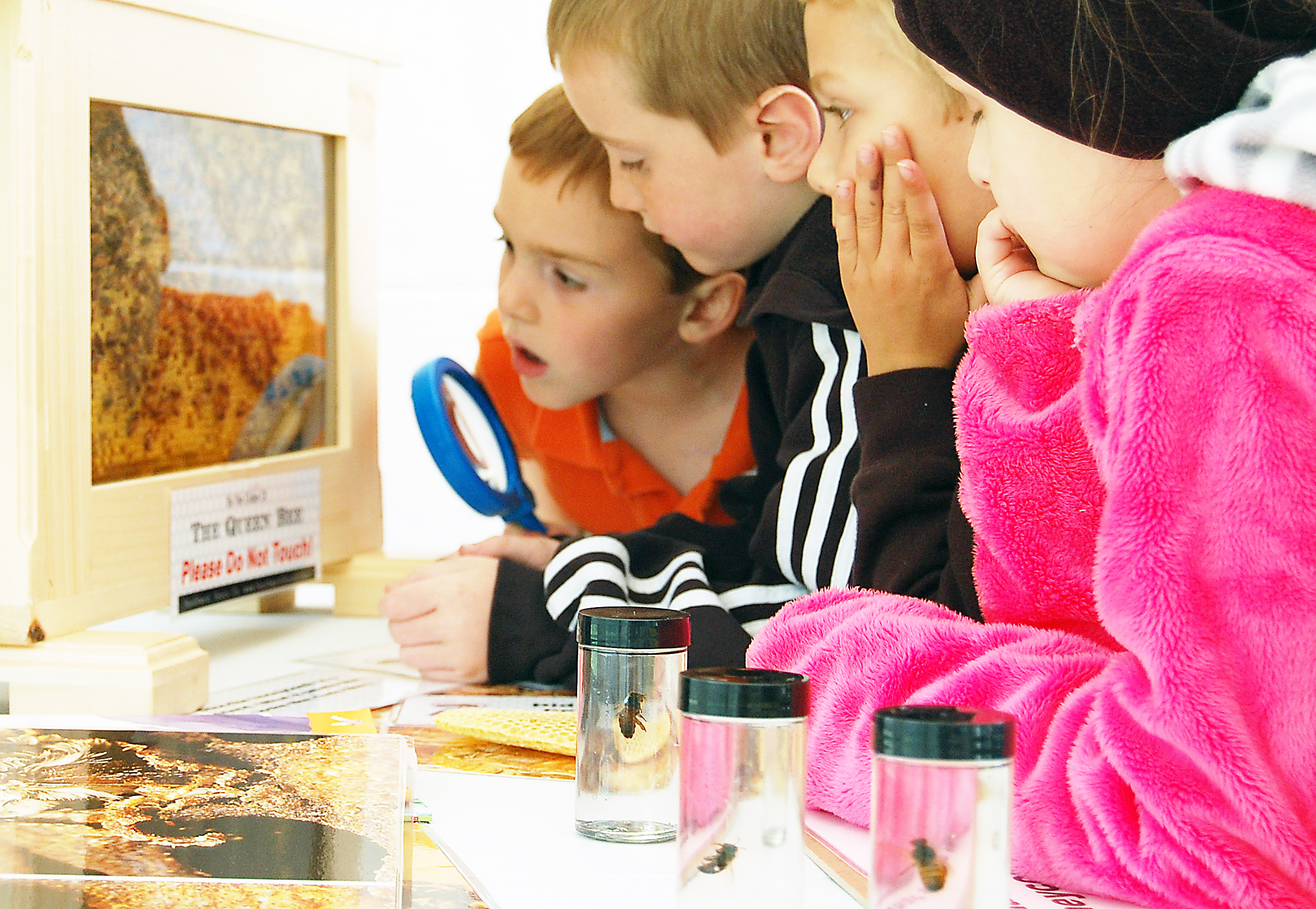 Children’s Program: “Explore the Honey Bee” was marketed as a fun, scientific, and hands-on experience that introduced children to the benefits of pollinators with a focus on the honey bee, allowing children to explore and grow in their appreciation of honey bees while connecting them to the food they eat. The pollinator education experience offered each “adventurer,” no matter their age, a genuinely unique learning experience. Students found themselves active and immersed in the learning. Incorporating movements, senses, and laughter created long-lasting learning.
Children’s Program: “Explore the Honey Bee” was marketed as a fun, scientific, and hands-on experience that introduced children to the benefits of pollinators with a focus on the honey bee, allowing children to explore and grow in their appreciation of honey bees while connecting them to the food they eat. The pollinator education experience offered each “adventurer,” no matter their age, a genuinely unique learning experience. Students found themselves active and immersed in the learning. Incorporating movements, senses, and laughter created long-lasting learning.
The children’s programs included three stations focused on the following:
- The first station gave students a scientific understanding of the honey bee’s anatomy and their life cycle using a digital microscope. Students had a multitude of petri dishes containing various insects and pollinators to view under the microscope. They also had the opportunity to try an activity that required labeling the body part of a honey bee’s anatomy. There was a third activity that involved hands on replicas of the life cycle stages of a honey bee which students had to put in order (egg, larva, pupa, adult).
- The second station contained the live observation hive where students could observe the bees. They also could use observation jars of preserved bees (workers, drones, and queens) to discuss and review the roles of all the bees in the hive. This station also allowed students to have the opportunity to touch and smell pieces of real honey comb.
- The third station allowed for the experience of tasting raw honey (for some students this was a first-time experience), trying on a beekeeper’s suit, exploring a Langstroth Hive with real frames containing honeycomb, and learning the use of basic beekeeping tools such a smoker, hive tool, and bee brush. This station also contained an interactive honey bee learning application on the iPad.
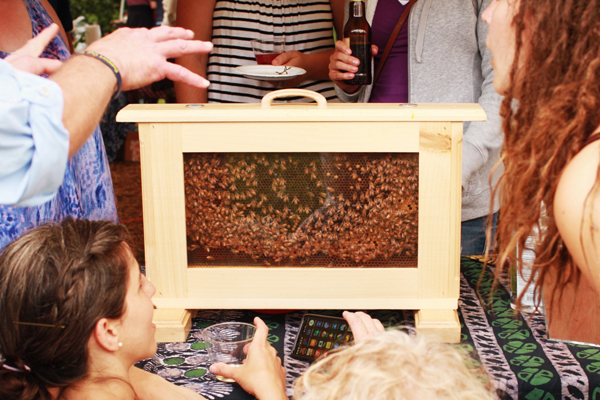 Adult Program: The adult programs were marketed to those looking for a refreshing new idea for date night, an excuse to get out of the house with friends, or simply a chance to do something unique. A program where there was something for everyone; the creative, the adventurous, and the curious. It was a chance to spend an evening exploring the honey bee through hands-on fun that included beeswax candle making, sampling raw honey, observing a hive up close through the observation hive, and suiting up and visiting the apiary for an up close and personal view of a honey bee hive.
Adult Program: The adult programs were marketed to those looking for a refreshing new idea for date night, an excuse to get out of the house with friends, or simply a chance to do something unique. A program where there was something for everyone; the creative, the adventurous, and the curious. It was a chance to spend an evening exploring the honey bee through hands-on fun that included beeswax candle making, sampling raw honey, observing a hive up close through the observation hive, and suiting up and visiting the apiary for an up close and personal view of a honey bee hive.
The adult program included three stations focused on the following:
- The first station was focused on educational experiences. Participants had the opportunity to view the sealed observation hive of live bees. With the help of educational experts and trained beekeepers, participants had the chance to ask questions and dig deeper into the innerworkings of a honey bee hive. Participants also had the opportunity to taste raw honey and touch pieces of real honey comb while discussing the importance of buying locally sourced honey with the volunteers at this station.
- The second station gave participants the opportunity to suit up and visit an apiary and see a live hive in action. This was done with a professional beekeeper who gave instructions and answered questions through a show and tell type of conversation.
- The third station allowed participants to make and pour their own beeswax candle. This was done with trained volunteers who also used this opportunity to discuss the many benefits of all the by-products of a honey beehive.
Senior Program: This program was marketed as a chance to enjoy a relaxing time at the Southwest Conservation Club surrounded by nature, flowers, and natural beauties as participants explored the world of the honey bee, the intricacies of the hive, how honey bees communicate, and how the honey bee effects our ecosystem and what they can do to help.
With respect to many having limitations with mobility, following the presentation, seniors were invited to come up to an educational table where they could see the honey bees up close in the sealed observation hive, ask questions, explore the educational literature, and enjoy a cup of tea with local, raw honey.
Funding
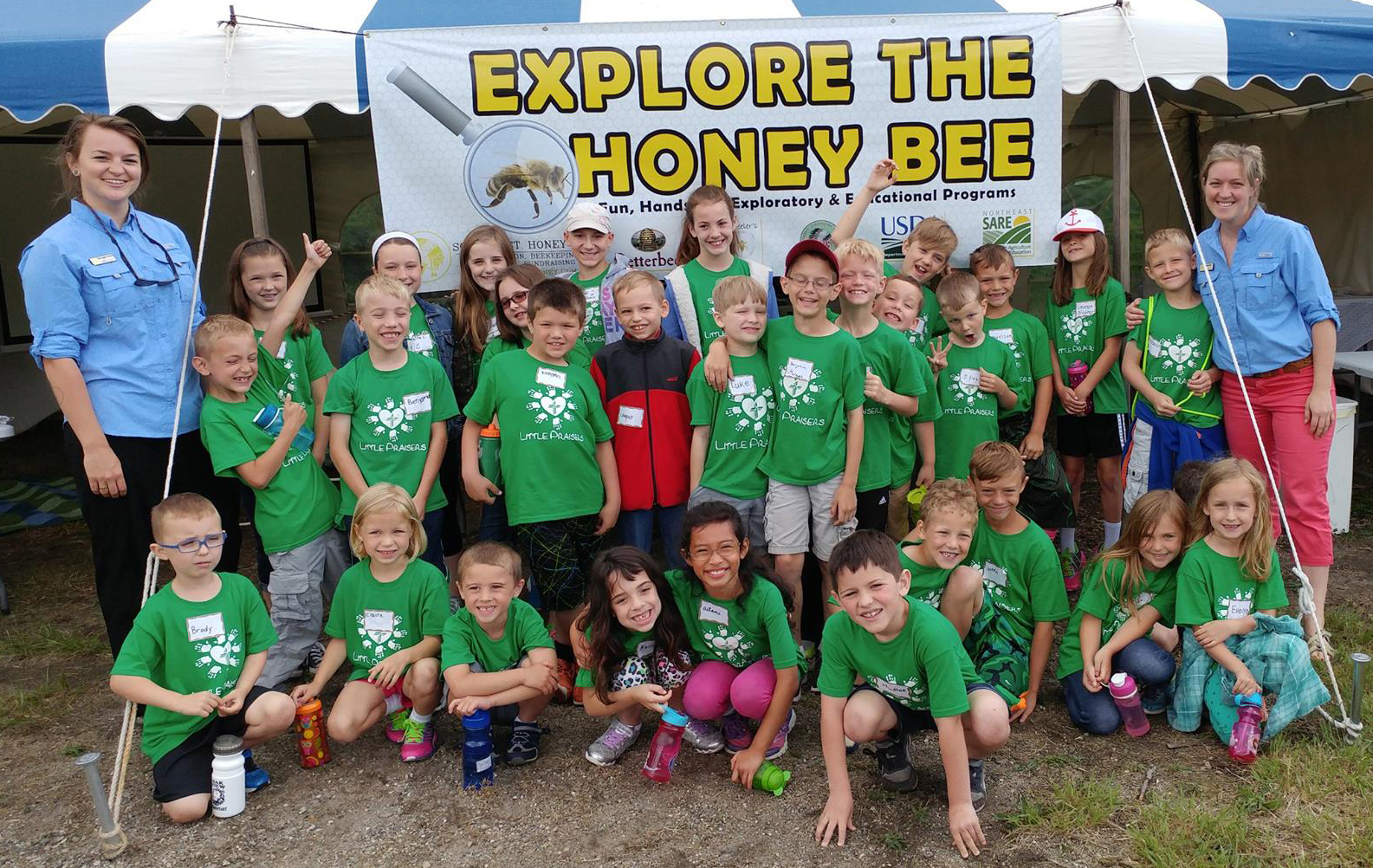
There was a small cost involved for each participant in all the programs described above. Children and seniors paid $5.00, and adults paid $35.00 (due to food provided and candle making materials needed, adult fees were higher). Effectively, through the funding provided by the grant, participant fees were kept low enough to allow all those wishing to participate a chance to come and learn about honey bees.
Timeline
In 2016, the children’s programs were held weekly, primarily under the outdoor ‘Science Exploration Tent’ at the Southwest Conservation Club. The adult programs also took place at the ‘Science Exploration Tent.’ In July of 2016, a program for seniors took place at a local assisted living facility. In 2017, the children’s program became more versatile and were also taken on the road to travel to locations around the community such as the Allen County Public Libraries and various summer camps which did not have the ability to transport their campers to the ‘Science Exploration Tent’ for a field trip. Adult programs continued at the Southwest Conservation Club.
Data was collected through the surveying of each adult (18+) participant of the education program. Since the data collected is intended to evaluate personal actions and thoughts, the questions asked were in a Likert-type format. However, a special consideration was given to developing the questions asked in order to limit opinion-based answers. Data from surveys were compiled and displayed in a visual graph format in order to show relevant comparisons.
Survey Consistency & Process
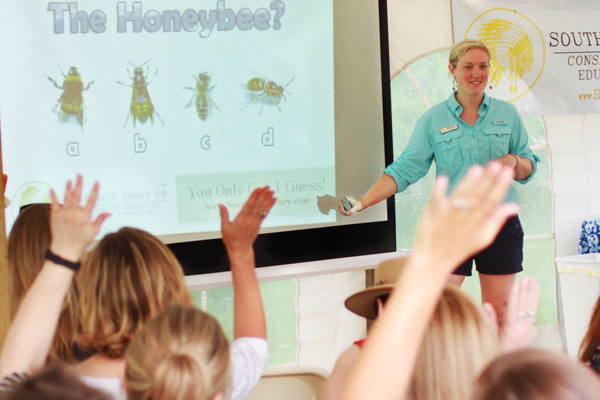 Each survey was administered at the same time throughout each survey taker’s timeline, so as to evaluate the impact of their educational experience before and after participating in the program. All instructions and questions were kept consistent with each survey given. The only instruction the participant received were the instructions included at the top of the survey.
Each survey was administered at the same time throughout each survey taker’s timeline, so as to evaluate the impact of their educational experience before and after participating in the program. All instructions and questions were kept consistent with each survey given. The only instruction the participant received were the instructions included at the top of the survey.
Each participant was given the option to opt-out of the survey as well as any questions they did not want to answer. If a question was opted-out of or incorrectly completed, that question for that participant was not considered in the results.
Timeline: A series of three surveys were given to the participant.
- The ‘pre-survey’ was administered via paper to each participant before beginning the program. This was intended to evaluate the participant’s prior knowledge as well as any actions they are partaking in before any influence of the educational program.
- The ‘post-survey’ was administered via paper directly after the program was completed. This is intended to evaluate if the participant was open to making changes that would positively impact honey bees and pollinators.
- The ‘long-range survey’ was administered 6-8 months after participants had completed the program. Participants were encouraged via email to complete this survey online. Those who did not respond were then mailed a paper copy with an envelope that was pre-stamped. The survey asked very similar questions to the ‘pre-survey’ and was intended to display if any actions were taken regarding honey bees and pollinators.
Questions: The number of survey questions were limited to a single page, in order to not overwhelm the participant and to receive the most amount of participation possible. The questions asked covered the following topics:
- Food Shopping – How frequently the participant shops at a commercial grocery as opposed to a local produce vendor, how important they feel local produce is, whether they seek organic food options, if they purchase honey and whether it’s a local source.
- Gardening & Lawn Care – Whether they have a garden and what they grow, if they actively seek plants not sprayed with chemicals, if they actively seek native plants, if they treat their lawn with chemicals and if they are aware of the impact on pollinators.
- Outdoor Appreciation – How often they spend an extended period outdoors, whether they have participated in an outdoor, nature-related activity, and whether they are active in conservation projects.
- Beekeeping & Pollinator Awareness – Evaluation of how important pollinators are, whether they are, have been or want to be a beekeeper, if they know that honey bees are experiencing issues and an evaluation of how severe they think those issues are, and if they are aware of what neonicotinoids are.
- Education & Research – Whether they previously knew about our NCR-SARE grant, how they felt the program went, if they learned something they didn’t already know, if they felt they have a greater appreciation for pollinators, whether they felt the program should be a part of school curriculum, and any additional comments.
Samples of all surveys used can be found here.
Considerations of Data
Many considerations were taken to create a similar experience for every participant of the program. However, there are variables that could not or were not controlled for this research.
- Program Types - Three types of programs were held for children, adults, and seniors and were catered to each age group. Each program was designed to generate interest and attraction to excite participants and provide enjoyment of the event itself. Each age demographic had different learning styles, so some of the activities differed according to their age range. However, in all programs, regardless of age, the exact same presentation slides accompanied with similar commentary was utilized to illustrate key educational points.
- Additional Information - In each program held, participants were encouraged to ask questions. The knowledge received from questions asked by participants may have differed from program to program. However, in every program baseline knowledge was established through the presentation and activities.
- Environment - Programs were held in various environments, including outdoor and indoor spaces, as well as at different times of the year. However, the setup of activities and presentations were closely mirrored from program to program.
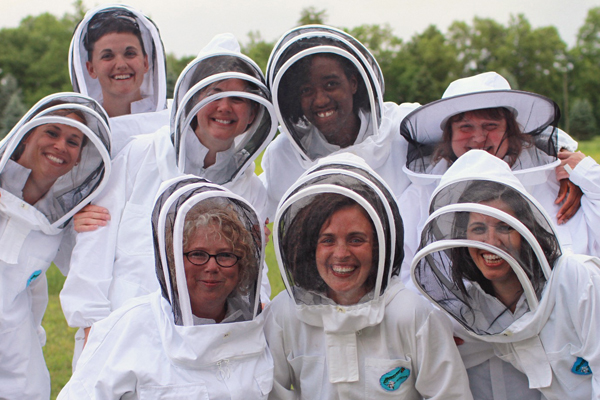
Survey Takers
The majority of the survey participants included in this study listed their zip-code as within a 30-mile radius of Fort Wayne, Indiana. Those adults surveyed from the children’s programs attended to assist their children in the learning process. However, all other participants were direct participants of the program.
The ‘control-survey’ was completed by 57 adults, who had an average age of 42.
The ‘pre-survey’ and ‘post-survey’ was completed by 282 adults, who had an average age of 39. Of those participants, 86 completed the ‘long-range survey’ and had an average age of 44. Though multiple attempts via email and US Mail were made to collect ‘long-range surveys,’ of all participants who took the first two surveys, only 31% of those participants completed the ‘long-range survey.’
Control-Survey
To create a control group, the same ‘pre-survey’ taken by program participants was taken by random adults at the closest commercial grocery store. The intention of this control group is to display the average consumer’s knowledge and actions regarding pollinators. This survey was administered when shoppers left the store and were given the option to take the survey. The comparative data results from the control group and the ‘pre-survey’ were intended to display any significant differences between program participants and the average consumer in the area.
Data - The control-survey (yellow), taken by 57 survey takers is shown visually by percentage and is displayed in comparison with all of the program participants’ ‘pre-survey’ (blue) data taken by 282 adults.
In consensus, ‘pre-survey’ takers were conducting similar activities and making choices that impacted pollinators more negatively than the ‘control-survey’ takers, prior to an educational influence. This data concludes that in all areas of consideration, those who participated in the educational programming were comparative to the average consumer. Because the participants and the ‘control-survey’ group showed similar conservative efforts it can be concluded that data results were not swayed because of prior knowledge.
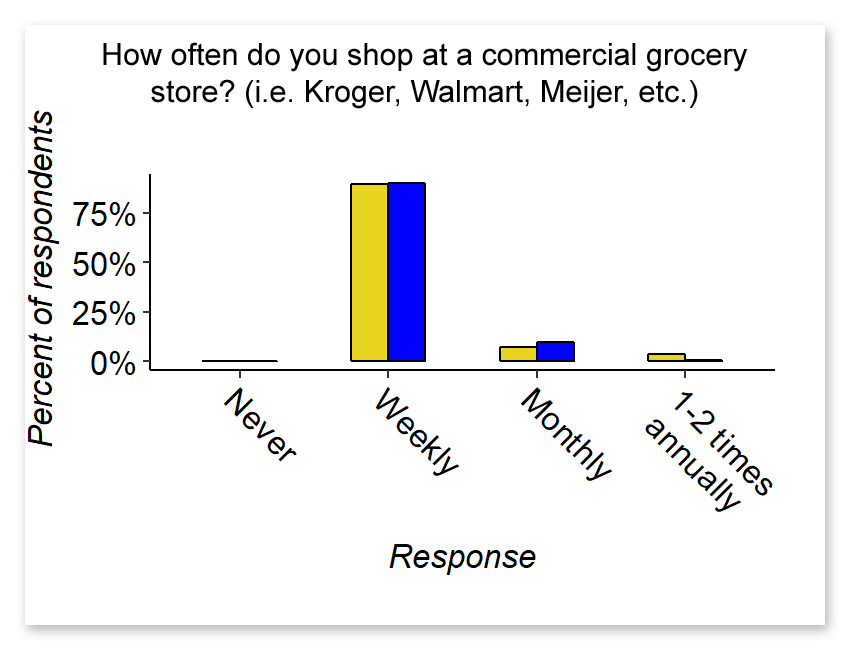
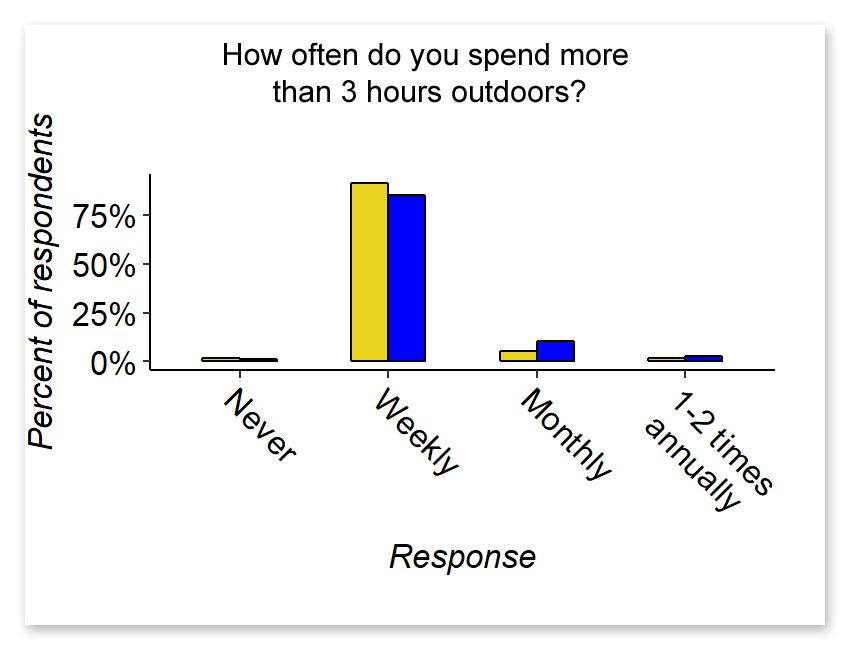
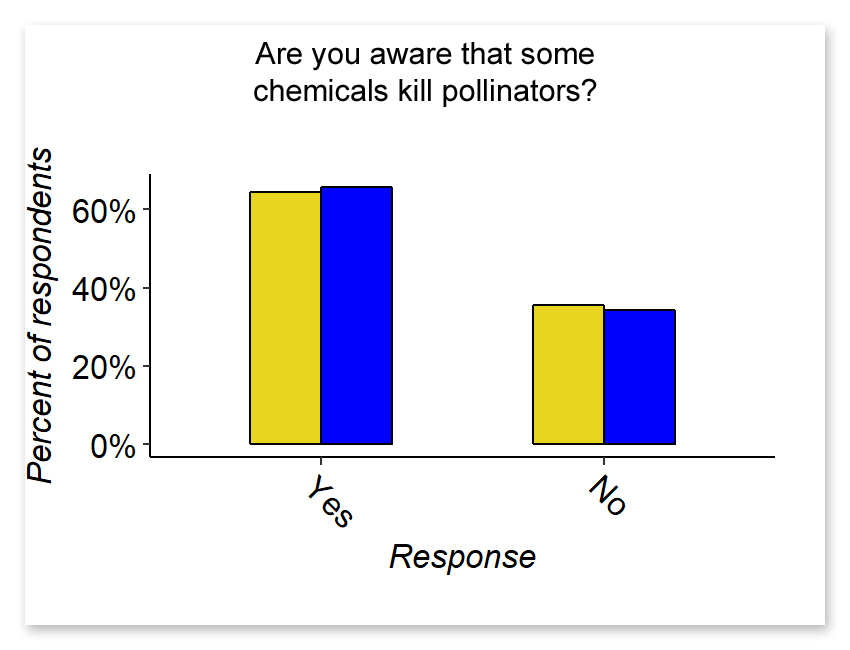
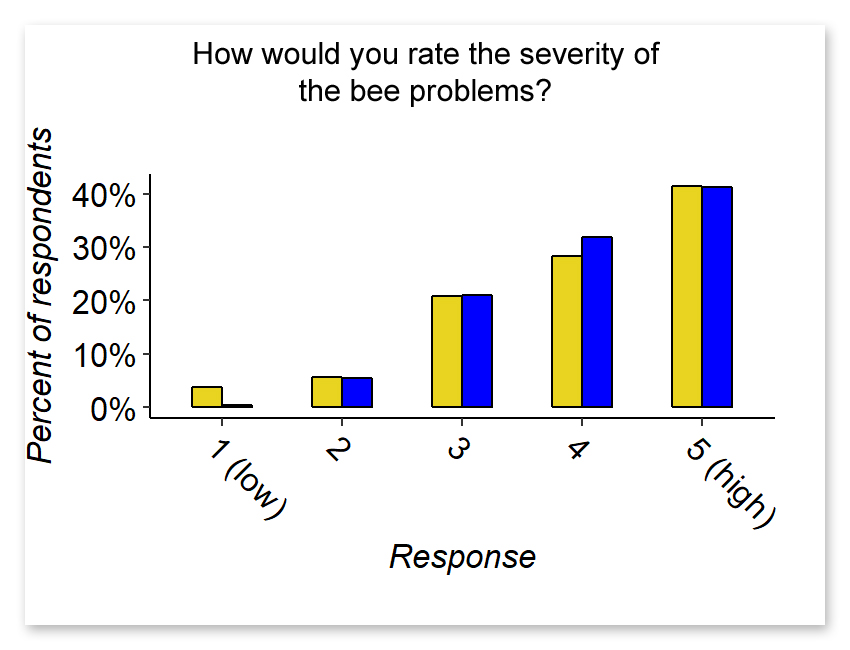
Exceptions - Overall, ‘control-survey’ takers and ‘pre-survey’ participants displayed similar choices within a 7% margin, considered to be close enough for consistency. However, there were some questions that were answered that displayed more than a 7% difference. Divergent from the control group, program participants were more likely:
- to actively seek organic food options
- to have a pre-existing garden
- to hike, camp or visit a nature preserve
- to have been or are considering becoming a beekeeper
- to be aware that honey bees are experiencing difficulties
Post-Program Survey (Commitments)
Directly following the program, participants completed a survey which contained questions that reflected similar themes to the ‘pre-survey.’ This survey was designed to evaluate participant understanding of the subject matter and whether they planned to apply the knowledge they had gained to choices in their lives.
Data - The survey data in consideration includes questions from the ‘post-survey.’ 282 participants completed both the ‘pre-survey’ and ‘post-survey.’
In general, participants displayed a significant desire to make changes in the future. It appears that participants not only understood the subject matter, but they also understood that changes that they could make in their lives would help pollinators. According to their answers, participants answered positively to a commitment of change in every category and they showed little or no sign of regressive behavior.
Food Shopping - In general, participants displayed the desire to change their shopping habits to benefit pollinators. Those who chose to commit to buying more local produce, seeking organic produce more often, sourcing their honey from a local farmer and shopping at a commercial grocery less understood that this choice would positively impact pollinators and they were willing to do so. In all question instances, more than half of the participants chose to answer in a way that would positively impact pollinators. In some instances, over 75% of the participants showed a significant desire to change shopping habits, including topics relating to buying local produce and local honey more often.
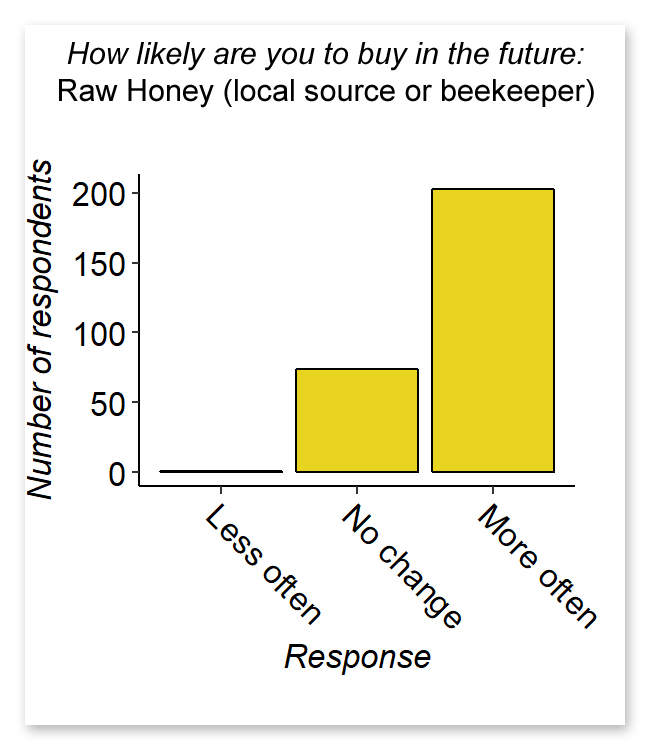

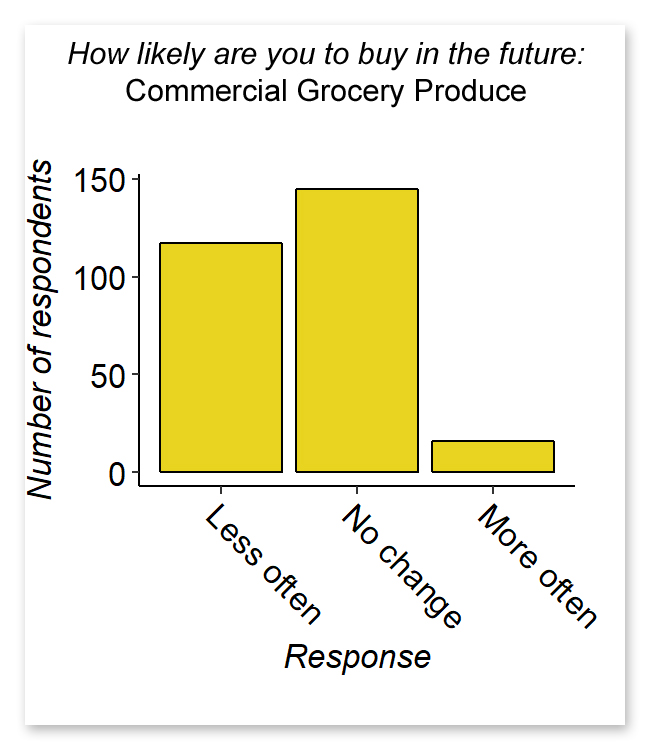
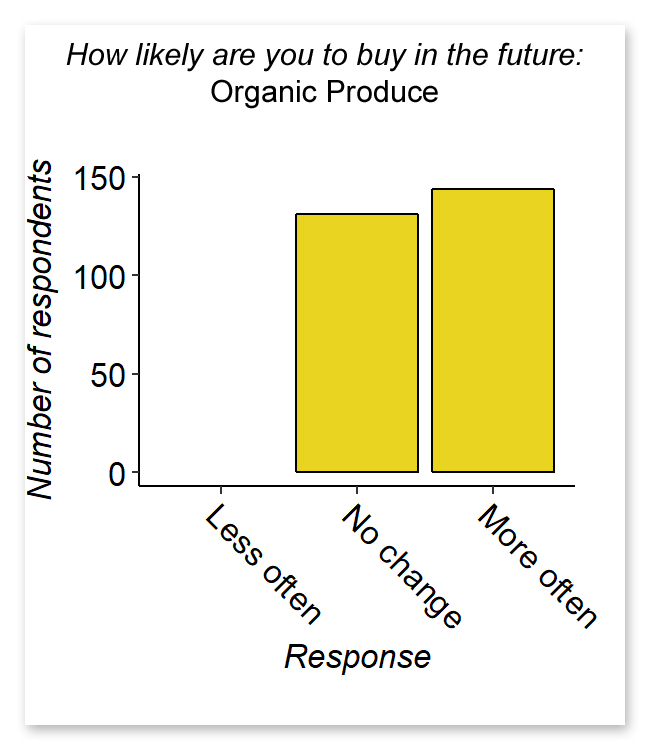
Gardening & Lawn Care - Participants showed a significant desire to either start a flower or vegetable garden, and to make special considerations in their gardening that would benefit pollinators. About 40% of participants who didn’t already garden, were moved to start a garden in the future. Over 75% of those who said they had a garden or were planning to start one were going to make special considerations in some manner for pollinators.
Participants also showed a significant amount of interest in ceasing or modifying their lawn treatments in the interest of benefiting pollinators. About 85% of participants who treat their lawn, displayed plans to either cease or reduce lawn treatments in the future.
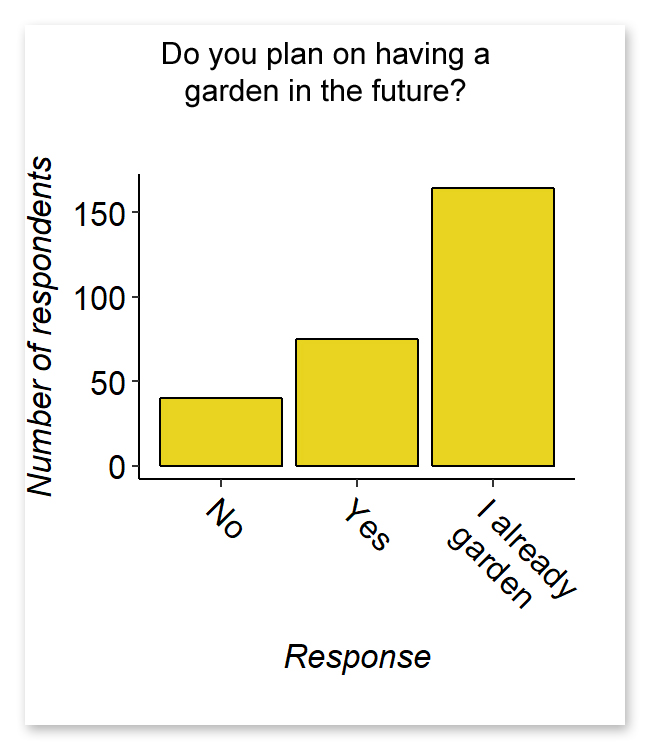
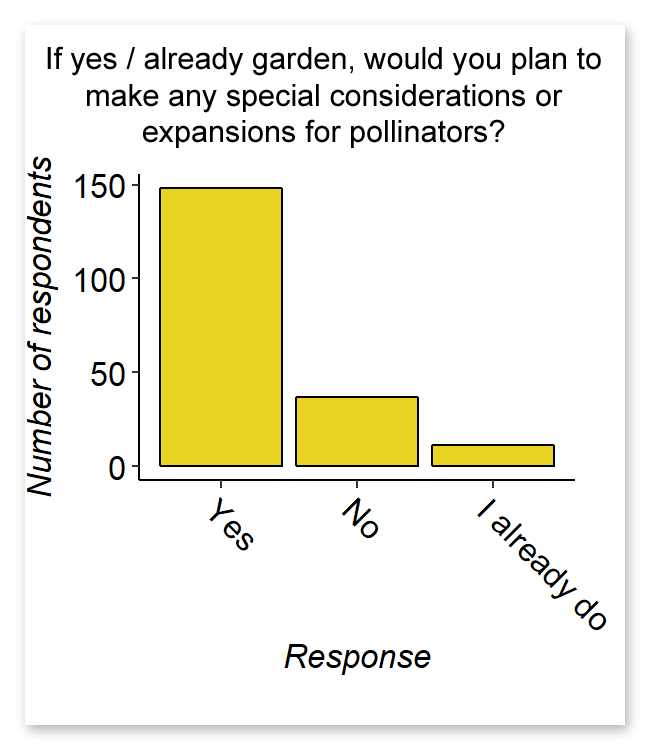
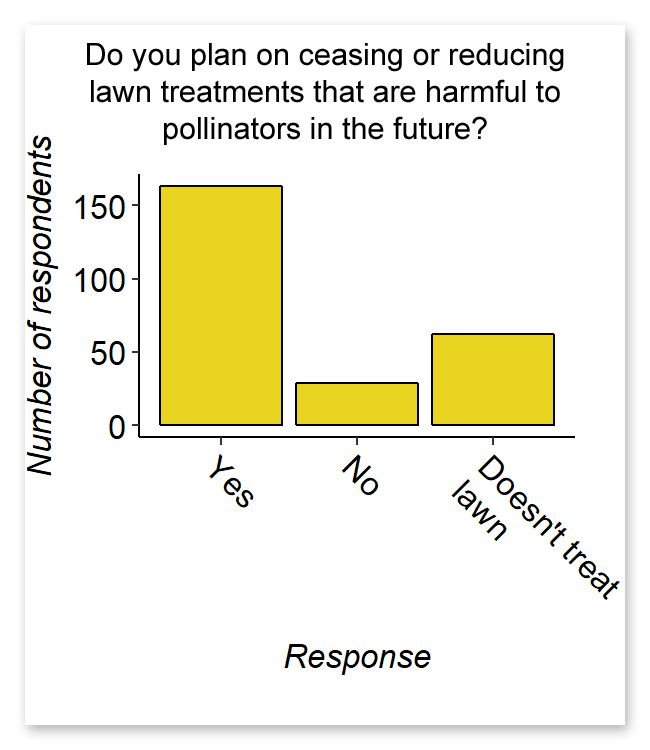
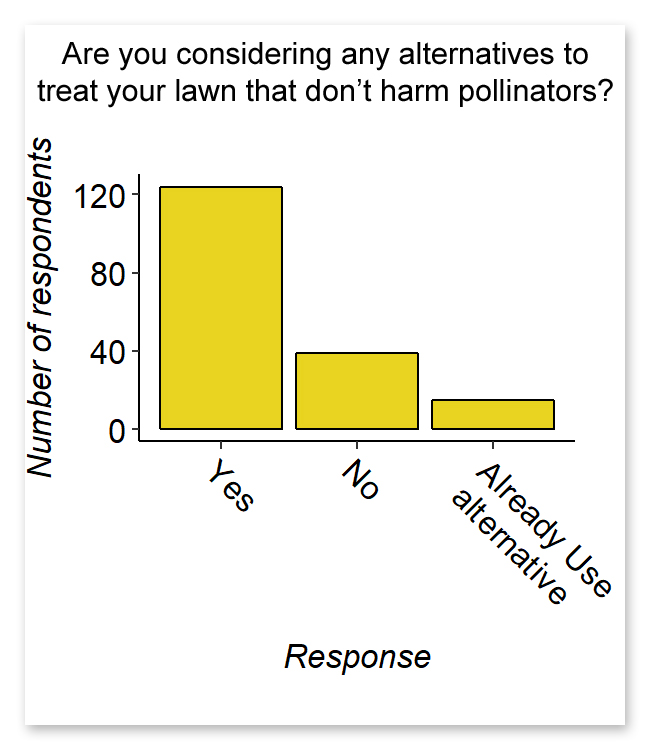
Beekeeping & Pollinator Awareness - Over 95% participants felt that they had a greater appreciation for pollinators and about 75% said they were planning to take active steps to help honey bees. Almost all participants rated their feeling of the importance of pollinators at a 3 or above, and more specifically, a majority of participants rated the importance at the highest rank of 5.
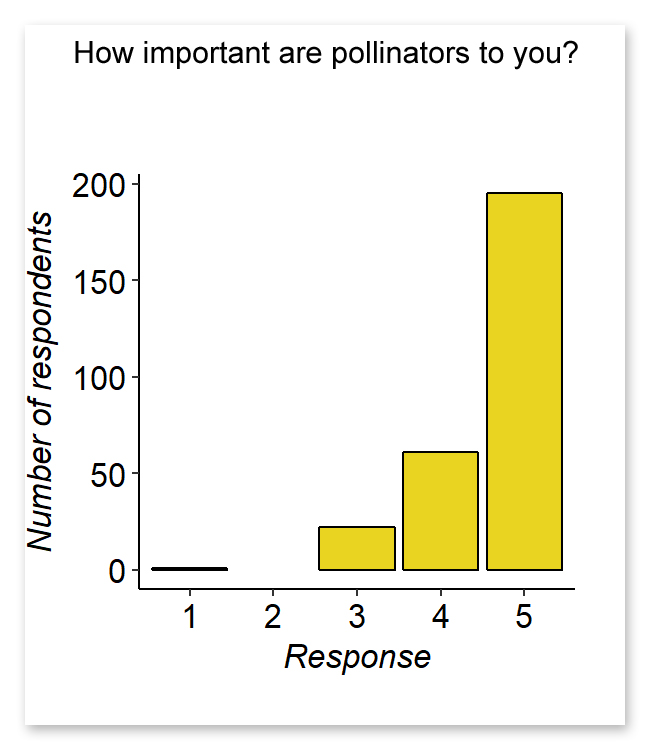
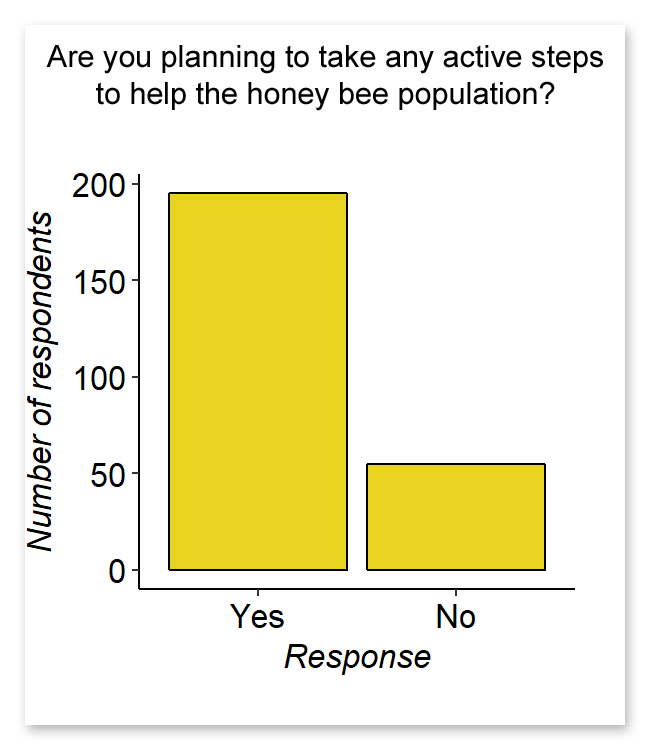
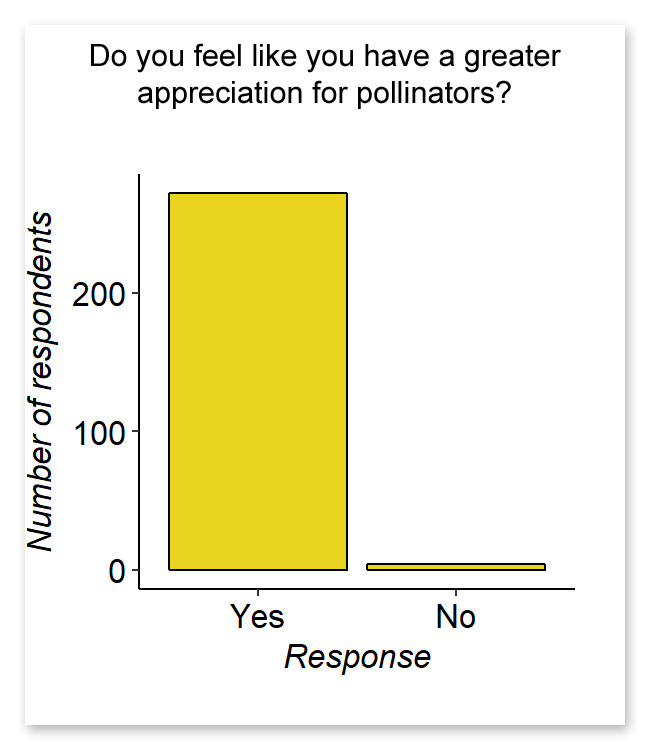
Program Experience & Education - In the interest of evaluating the program itself, participants rated their experience as overwhelmingly positive which they rated in the top tier of the rating system. Beyond their individual experience, about 95% of participants felt that pollinator appreciation programs, such as the one that they had experienced, should be in their child’s classroom or in schools in general. This shows a significant interest and feeling of importance of pollinators, to the point that it should be part of general education in school curriculum.
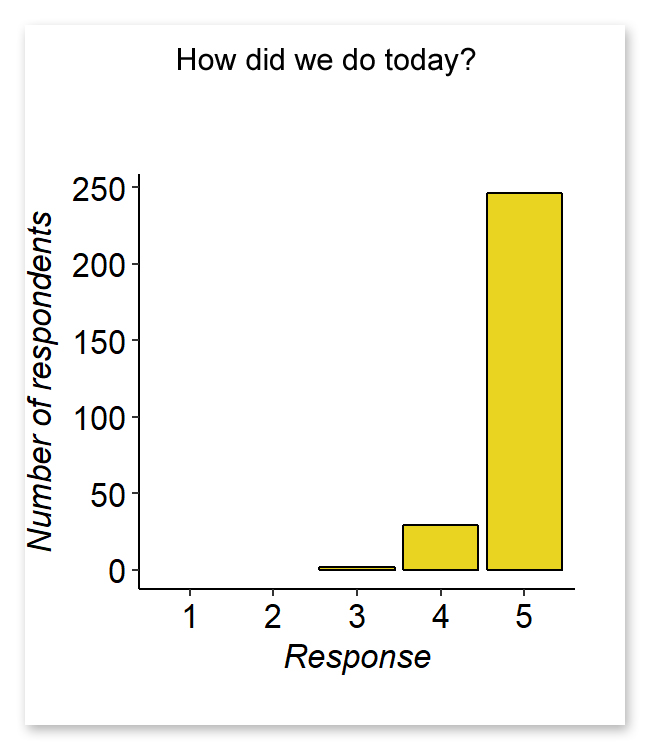
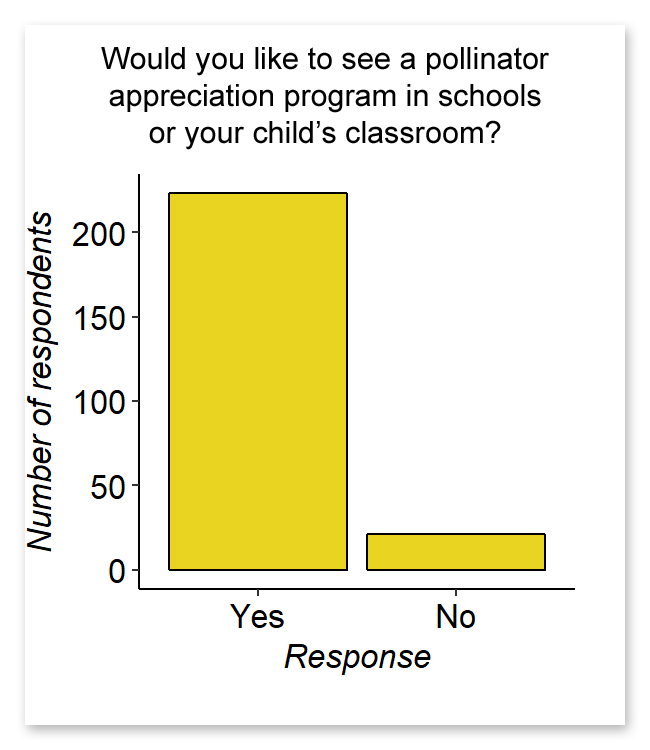
Long Range Survey (Actions Taken)
The survey data in consideration includes question answers from the ‘long-range survey’ in comparison with their ‘pre-survey.’ The ‘long-range survey’ is intended to evaluate whether a participant made any changes at the time it was administered, about 6 to 8 months after they had participated in the program. The questions on the survey were phrased using exact words matching the ‘pre-survey.’
Data - The data presented in a visual format accounts for those who participated in both the ‘pre-survey’ (yellow) and ‘long-range survey’ (blue).
In general, participants displayed small improvements with regards to some topics and no significant change in others. Participants either began to make changes in areas they felt suited to their lives, had not yet implemented changes, or chose to not make any changes. However, no regressive behavior was found.
According to ‘post-survey’ results, most participants felt they wanted to make significant changes, so it was hypothesized that many would begin to implement changes, although that did not prove true in the timeline of the ‘long-range survey’ data. Not represented in this data is the cause or rationale for their lack of implementation of changes. These causes could perhaps be financial, lack of time to implement, lack of material or informational resources, or other personal circumstances.
The following is a sample of responses from participants that may explain the lack of implementation:
- “I think more follow up information on the specific steps we can take would be useful!”
- “It is very costly to purchase organic on a fixed income. Wish I could afford more!”
- “I'd love to know more about where to purchase local/native flowers; wildflowers especially.”
Food Shopping - On average, participants continued their usual shopping habits when it came to shopping for produce whether at a commercial grocery or purchasing from a local grower. Participant opinions did not seem to change regarding whether they actively seek organic food options. There was a consistent increase in frequency when it came to honey purchasing and more participants reported buying honey from a local producer, such as a beekeeper.
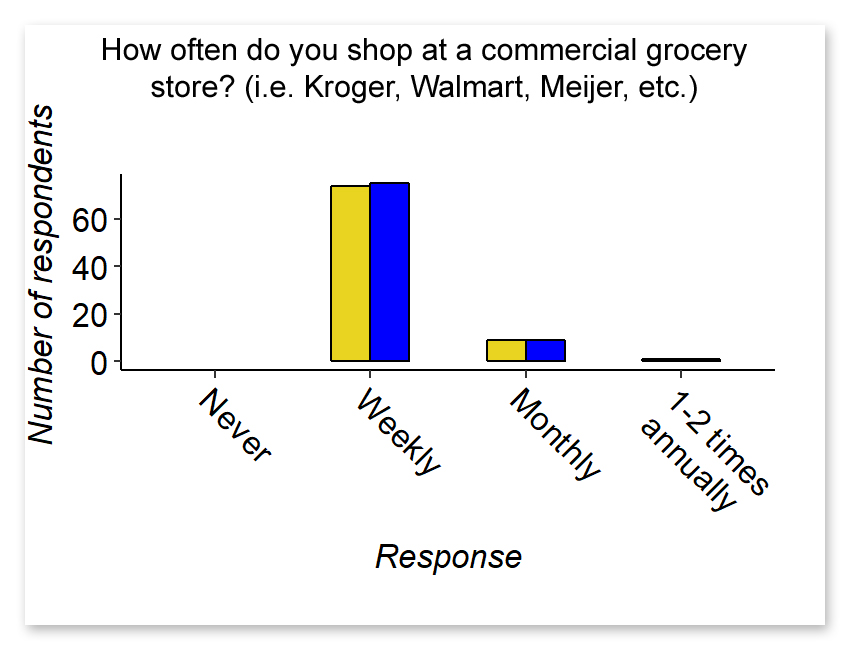
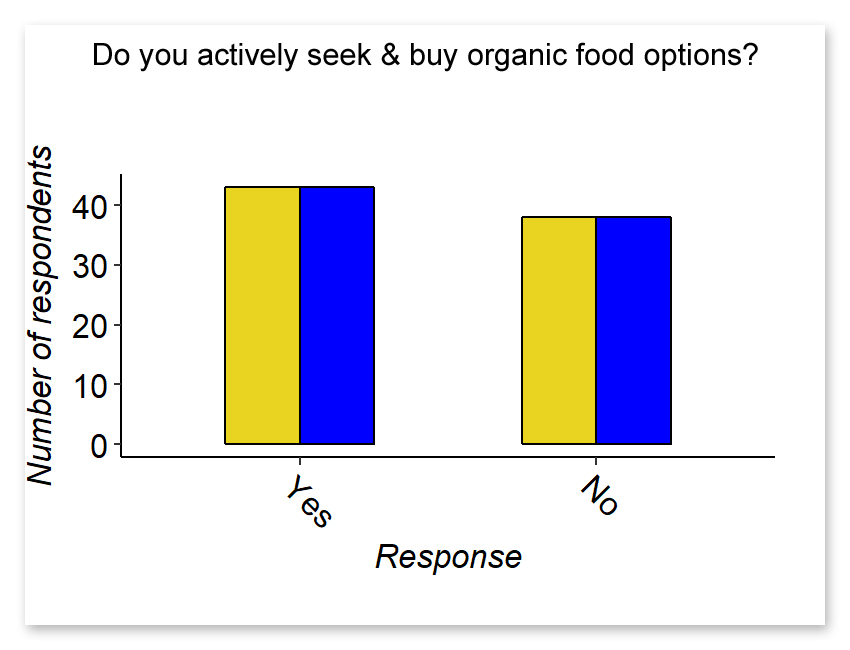
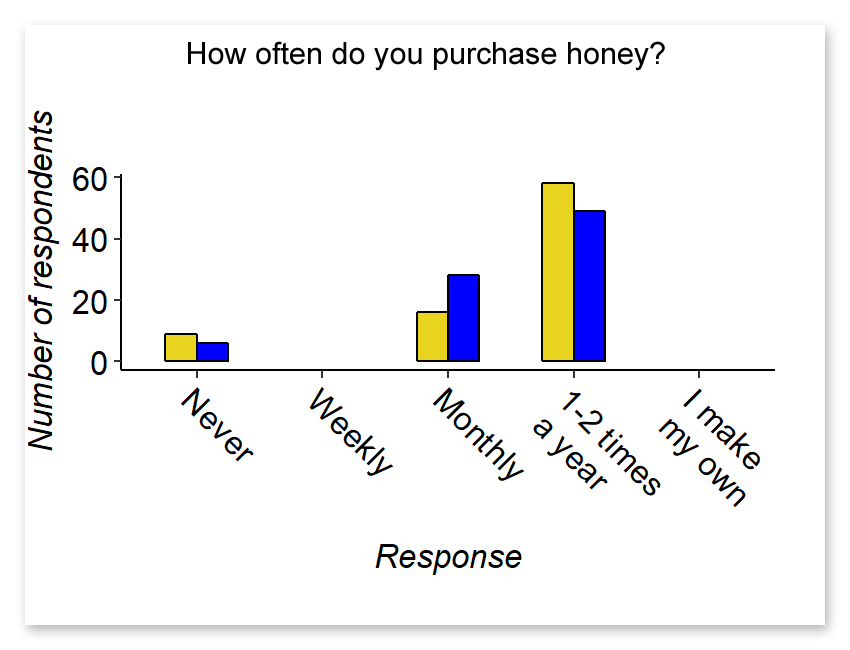
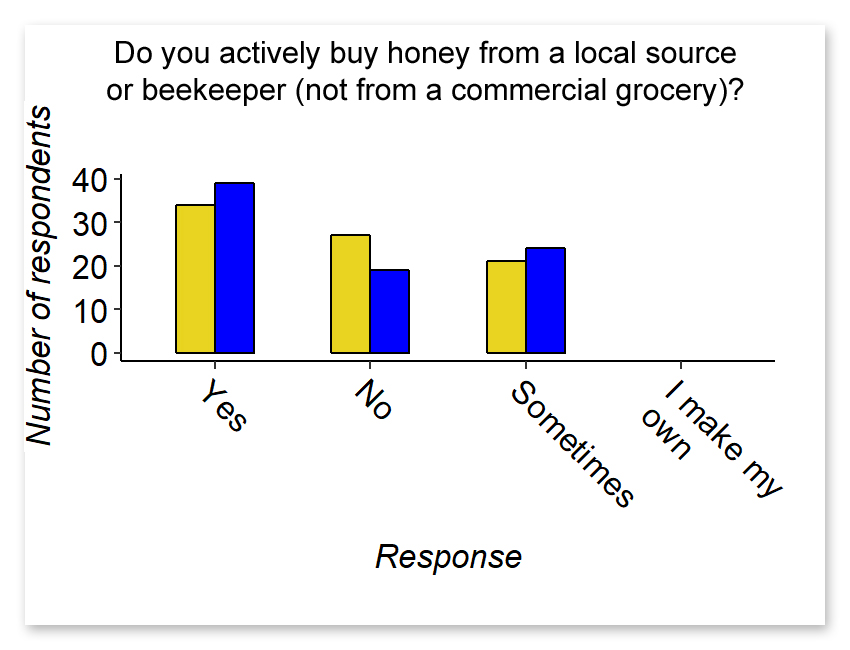
Gardening & Home Care - Participants showed no significant change in whether they had a garden and how they kept it. They also did not show a significant change when it came to lawn care and chemical treatments. However, due to the timeline of this research, it may be that participants had not had time to implement changes, as a new planting season had not occurred.
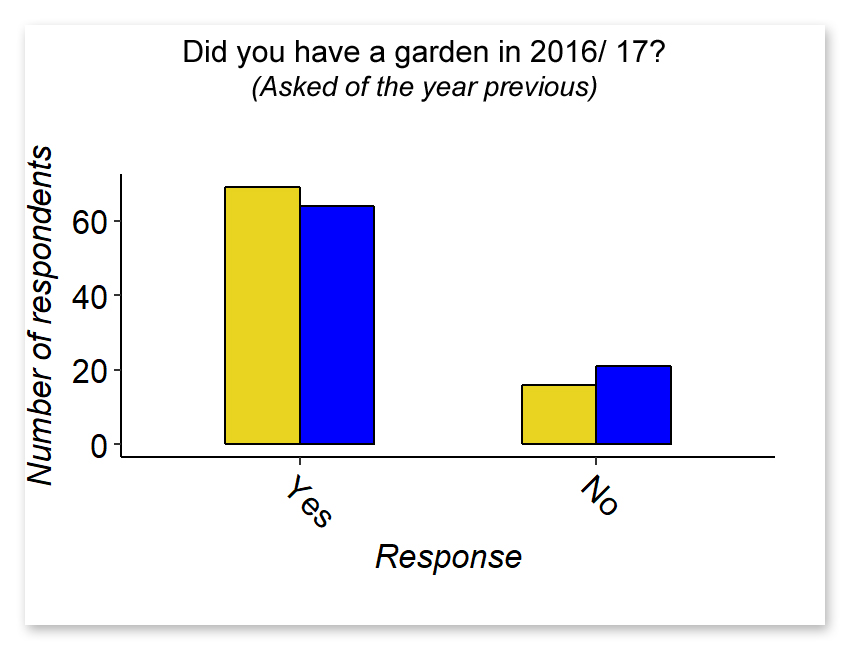
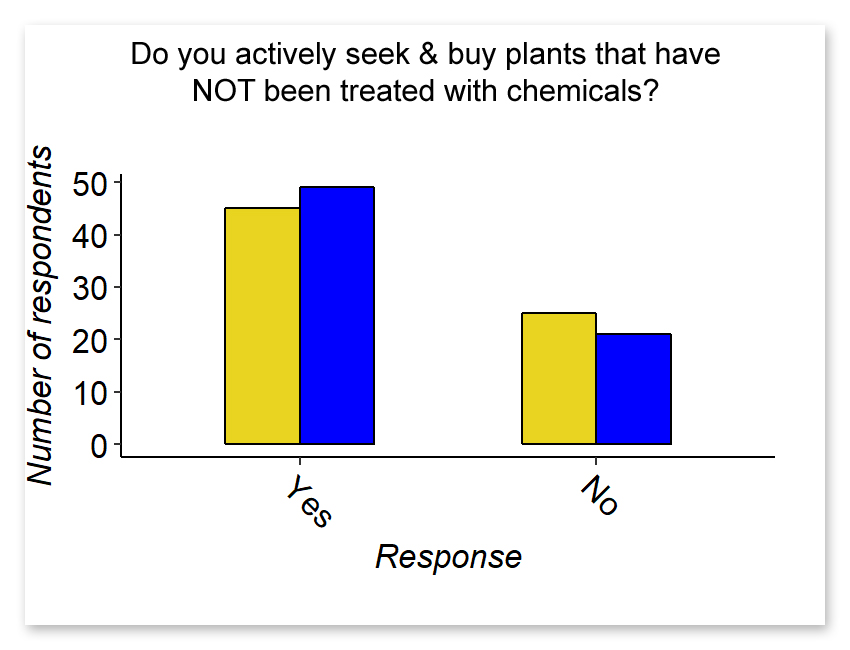
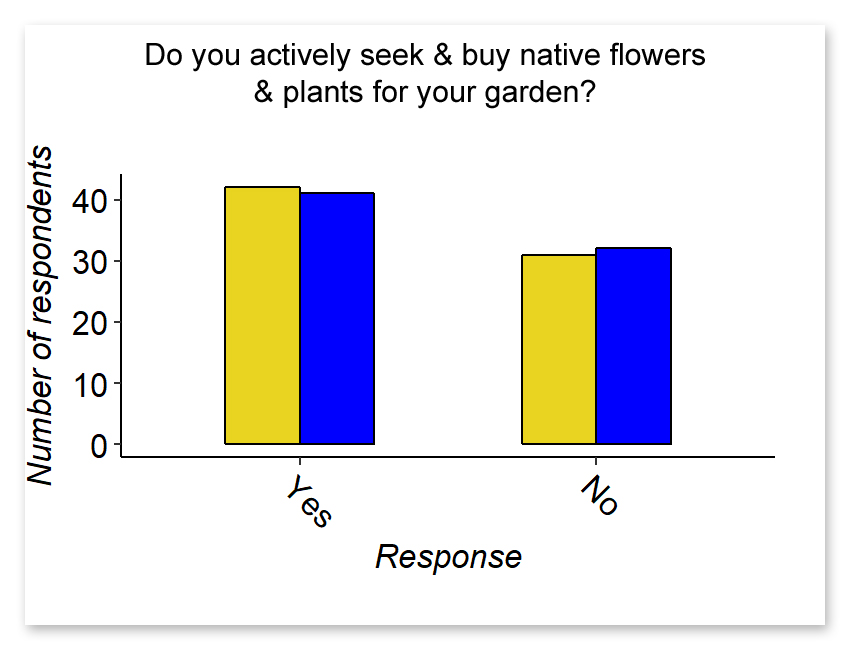
Pollinator Awareness - There was an increase in the way participants felt about the importance of bees and pollinators. They also strongly indicated that they felt that the bee problems continued to be severe.
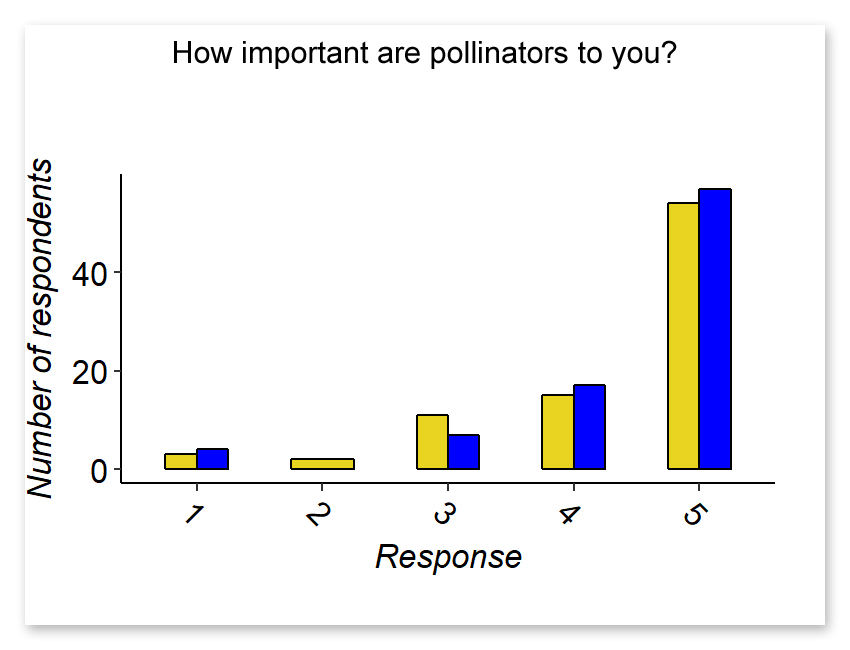
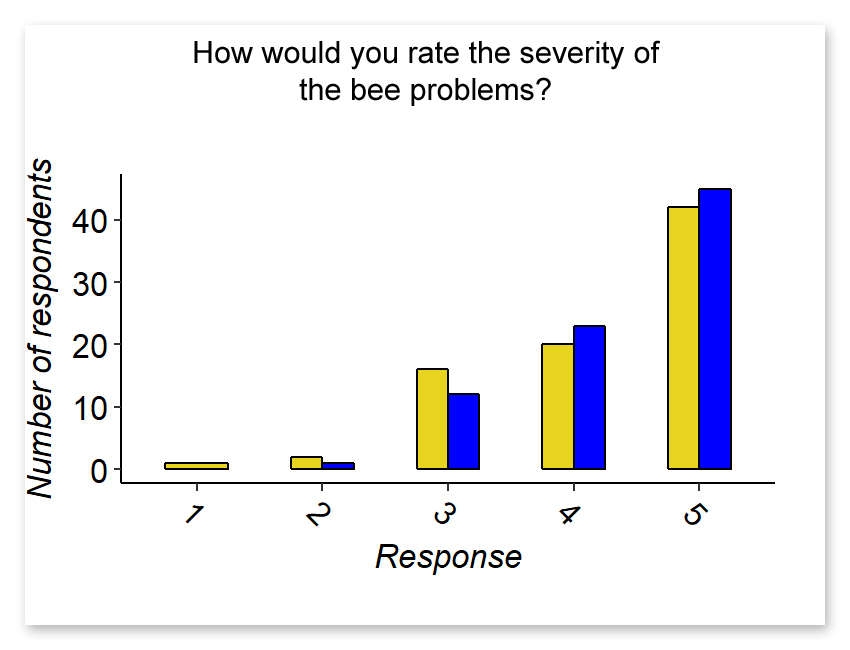
Beekeeping - According to a local beekeeping association, growth in membership has been substantial. From 2016 to 2018 there was a significant increase of nearly 100 members within the association going from 272 to 360 members..
Educational & Outreach Activities
Participation Summary:
 In order to create awareness about the educational programs and special events, many different platforms were used including local media, news stations, newspapers, beekeeping publications, interviews, social media, radio and more. Southwest Honey Co. was featured in over 75 local, regional, and national media outlets. Because the educational events centered on public participation, our primary emphasis was on traditional media and social media. Since the events presented a unique opportunity for people to participate in the Southwest Honey Co.’s mission, the media was eager to let people know about these events. However, in the media, we did not discuss the research portion of our grant to uphold the integrity of the data collected. The educational programs were highlighted in larger media outlets, most notably: “Farm Indiana,” “Bee Culture,” “American Beekeeping Journal,” Voice of America, and National Public Radio (NPR).
In order to create awareness about the educational programs and special events, many different platforms were used including local media, news stations, newspapers, beekeeping publications, interviews, social media, radio and more. Southwest Honey Co. was featured in over 75 local, regional, and national media outlets. Because the educational events centered on public participation, our primary emphasis was on traditional media and social media. Since the events presented a unique opportunity for people to participate in the Southwest Honey Co.’s mission, the media was eager to let people know about these events. However, in the media, we did not discuss the research portion of our grant to uphold the integrity of the data collected. The educational programs were highlighted in larger media outlets, most notably: “Farm Indiana,” “Bee Culture,” “American Beekeeping Journal,” Voice of America, and National Public Radio (NPR).
All press releases and news coverage of Southwest Honey Co.’s projects can be found here: https://southwesthoney.com/category/in-the-news/
Throughout the duration of this project, Southwest Honey Co. presented at events such as Earth Day with The Little River Wetlands Project, the Monarch Festival, Southwest Conservation Club meetings, Northeast Indiana Beekeepers Association meetings, Ohio Ecological Food and Farm Association Farm Tour at Wood Farms in Fort Wayne, Indiana, ACRES Land Trust Staff Hive Tours, Allen County Public Libraries, Science Central, along with countless hours spent in the apiaries training volunteers.
In conclusion, the final results of this study and project will be shared with the Northeast Indiana Beekeepers Association at their meeting in September, 2018.
Learning Outcomes
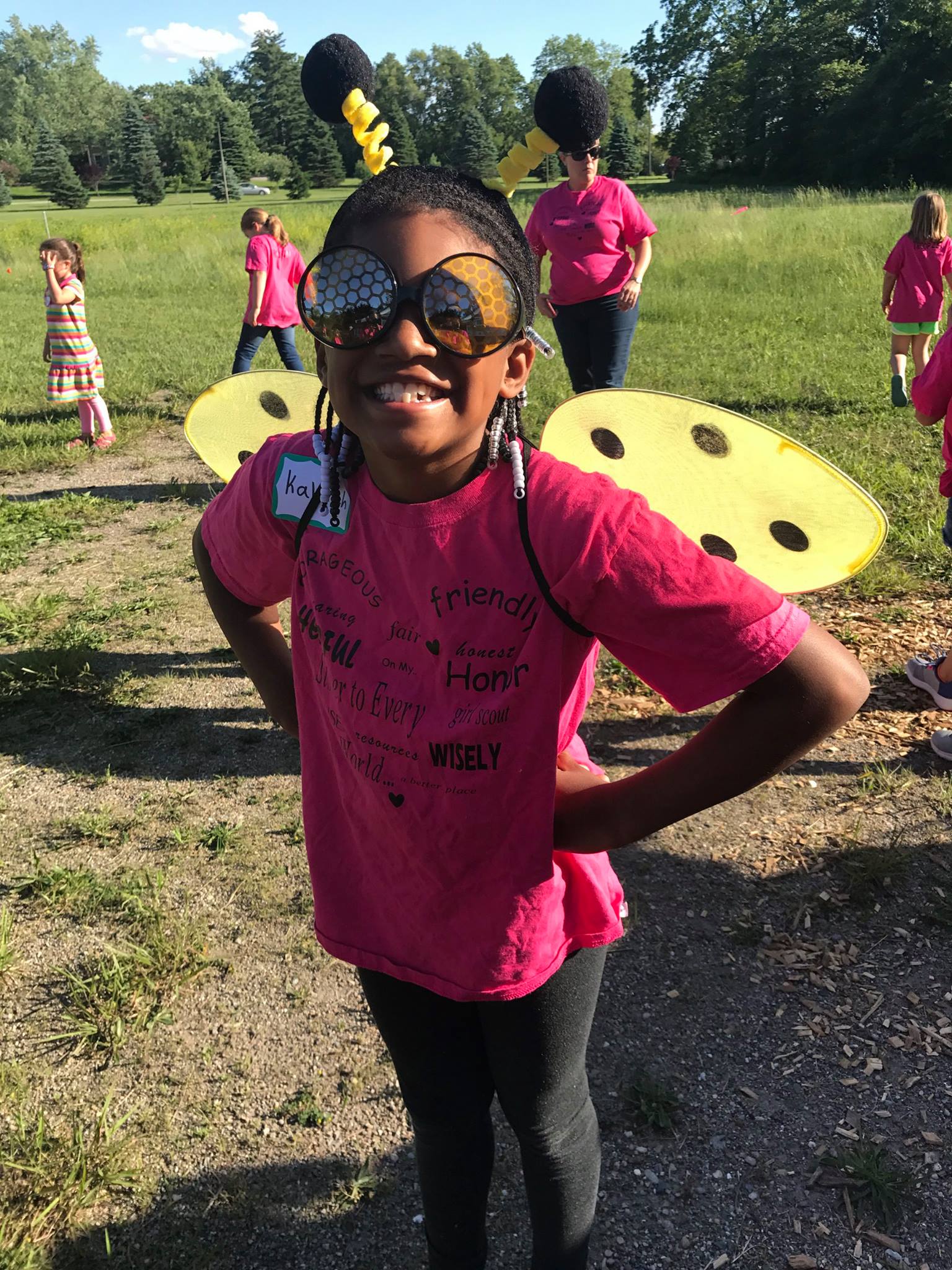 For those who participated in our program as students, much was gained by way of knowledge about honey bees and a deeper appreciation for pollinators, the role they play in our ecosystem, and the effect they have on the food we eat on a daily basis. Southwest Honey Co. volunteers also learned alongside the students over the past 2 years. From beekeeping skills, to presentation skills and working with kids all the way to honey extraction, Southwest Honey Co. made it a priority to give volunteers meaningful experiences in order to share those experiences with all those they encountered through the educational programs. Without exception, participants lingered after programs seeking more information and wanting to know even more about how they could help the struggling pollinator populations.
For those who participated in our program as students, much was gained by way of knowledge about honey bees and a deeper appreciation for pollinators, the role they play in our ecosystem, and the effect they have on the food we eat on a daily basis. Southwest Honey Co. volunteers also learned alongside the students over the past 2 years. From beekeeping skills, to presentation skills and working with kids all the way to honey extraction, Southwest Honey Co. made it a priority to give volunteers meaningful experiences in order to share those experiences with all those they encountered through the educational programs. Without exception, participants lingered after programs seeking more information and wanting to know even more about how they could help the struggling pollinator populations.
Effects of the Grant
The greatest effect this grant and program has had on Southwest Honey Co. was increasing the ability to connect with similar organizations that support the mission of what the program aimed to accomplish. Relationships with local organizations such as the following were built: The Southwest Conservation Club, ACRES Land Trust, Allen County Public Libraries, Foellinger-Freimann Botanical Conservatory, Little River Wetlands, Science Central, and many others. Overall, this grant allowed Southwest Honey Co. to initiate educational programs and outreach that will continue into the future, hopefully reaching surrounding communities. The continued growth of programs such as these will not only increase awareness for pollinator populations, but in turn, also help local growers and beekeepers.
Overcoming Lack of Awareness
Early on, a general lack of awareness in our community regarding the importance of pollinators and their connection to our food and ecosystem was apparent. The growth and awareness of the plight of the honey bee in the local Fort Wayne community has improved immensely. Looking to the future, it would be a benefit to see awareness grow and educational outreach programs such as this continue. Aided by the widespread media coverage given to Southwest Honey Co. the community of Fort Wayne and beyond were afforded insight into the world of pollinators.
Advantages and Disadvantages
This grant allowed us to use education to support not only the local honey bee and pollinator populations, but also local growers. Exposure gained from the programs helped draw awareness to the importance of actions such as buying local honey and produce at places such as farmers markets. The educational programs and community exposure also led to more honey sales that in turn helped further fund additional education programs and expenses not covered by the grant.
Throughout this this project Southwest Honey Co. was approached by many more groups in the community than it was possible to accommodate. This was the primary disadvantage encountered. There is a desire and a need in our community to educate both the young and the old in areas of conservation and protecting our environment.
Future Recommendations
Southwest Honey Co. encourages all forms of pollinator education. Soon, Southwest Honey Co. plans to publish materials and curriculum resources that will hopefully allow others to bring a program that mimics this one to their organization (beekeeping associations, girl scout troops, homeschool cohorts, science teachers, etc.).
Project Outcomes
Impact
From May of 2016 through the completion of our grant in May of 2018, Southwest Honey Co. reached 2,194 children, adult, and senior participants in the community through the educational outreach programs. As a testimony to the success and impact of the programs, many of the children’s groups who participated in 2016 also participated in 2017 and plan to return once again in the summer of 2018.
The program proved to create a meaningful connection with many of the children who participated. After the completion of the programs, Southwest Honey Co. received countless thank you cards as well as homemade honey bee arts and crafts from the students who participated.
In general, the participants felt that they left the program with a greater appreciation for pollinators. On the road to change, awareness is the first hurdle. These programs generated the needed awareness to begin the process of instilling change in the community regarding pollinator appreciation.
The following are samples of comments regarding specific changes participants made or awareness of changes needing to be made:
- “I have learned a lot from you and plan to exercise better habits concerning the pollinators.”
- “After watching the presentation, I better understand and acknowledge what to do to help.”
- “I learned a lot! Thank you! I feel bad that my dad used chemicals to kill the weeds in our yard. Now I am much more aware! You guys did a great job and all the hands on for kids was great!”
- “You are doing an amazing job. I have learned a lot from you and plan to exercise better habits concerning the pollinators.”
- “I started a wildflower patch this year.”
- “I loved attending your event. Thank you for your conservation efforts. I’m trying to help the bees as much as possible. I planted a native perennial garden and buy local honey now.”
- “I learned a lot. I will have ‘bee’ plants, more flowers, and buy local honey now.”
- “I try to treat my lawn with appropriate chemicals based on soil and seek local/regional options at Kroger/Meijer”
- “Thank you for the work you do and the education you provide. It made a difference in the way we shop and garden.”
- “This year I’m going to only get veggies in the garden that I know haven't been treated with chemicals”
 Extension of School Activities
Extension of School Activities
Not only was the program held in schools where students had no baseline knowledge of honey bees, but it was also used as an extension of learning in schools where entire case studies of honey bees was done prior to participating. One school in particular, in Goshen, Indiana, was moved to take their learning and appreciation of honey bees one step further. Students from this school continued their love for honey bees with a follow up activity that allowed them each to create, illustrate and narrate a “Save the Honey Bee” educational booklet that was then professionally printed and taken to the local community center to be distributed.
Based on participant responses, it was very apparent that the majority felt a similar program should be a part of the curriculum in schools. Here are some participant responses that relate to pollinator education being present in schools:
- “Please visit schools! Our future is in our kid’s hands.”
- “Please continue this program and expand it if possible. Great information, awesome presenters, love, love it.”
- “We would love to incorporate your program into our curriculum!”
- “Great job. It was very informative and fun. I would like to see if my son's daycare & school would be interested in visiting.”
- “I'd like to share with my principal to see if this would be a presentation for my (or another) class!”
Media Exposure
Due to the unique nature of Southwest Honey Co.’s educational programs and curriculum design, the local media was engaged in covering events and information relating to programs in the community put on by Southwest Honey Co. The programs provided a one-of-a-kind opportunity for members of the Fort Wayne community to engage with honey bees and pollinators in a new way. From May 2016 until the completion of the grant, Southwest Honey Co. and the educational programs funded through this grant were featured monthly in the local, regional, and national media including newspaper, radio, social media, and professional journals (American Beekeeping Journal and Bee Culture) just to name a few. A majority of the media coverage can be found here: https://southwesthoney.com/category/in-the-news/. SARE grant program coordinator, Joan Benjamin, asked to feature this story in the report: https://waynedalenews.com/2018/08/usda-research-will-residents-change-habits-after-pollinator-class/
Testimonials
 On all of the surveys completed by participants, there was an opportunity to fill in comments. Many participants utilized this space to write-in feedback, all of which was very positive about the program they had just participated in. Teachers and group leaders in all programs were asked to provide their input and testimonials, all of which provided exemplary reviews. Most were looking forward to scheduling a similar event in the following year.
On all of the surveys completed by participants, there was an opportunity to fill in comments. Many participants utilized this space to write-in feedback, all of which was very positive about the program they had just participated in. Teachers and group leaders in all programs were asked to provide their input and testimonials, all of which provided exemplary reviews. Most were looking forward to scheduling a similar event in the following year.
The following is a small sampling of testimonials from our children’s program, “Explore the Honey Bee.” Further testimonials can be found on Southwest Honey Co.’s website (southwesthoney.com):
- The “Explore the Honey Bee” program was a wonderful and highly interactive experience for our students to explore beekeeper tools and all things bee related in a scientific way. It left our students even more excited and eager about bees. CCD (Colony Collapse Disorder) was of particular interest for our students as it was a topic we had not learned about prior to Southwest Honey Co. coming! (Goshen Schools, 2nd Grade Teacher)
- I feel that the ‘stations/centers’ that the kids rotated through really helped them to learn about the honey bee and beekeeping; it definitely added to their understanding of the honey bee, especially since we have the observation hive here at the Conservatory. As an educator, my favorite part was the “hands-on” activities. I am definitely interested in scheduling another program next summer. (Fort Wayne Conservatory, Summer Camp and Kids Program Director)
- We had a great experience with both Megan and her program. The Mini 4-Hers really enjoyed it. Megan was very well organized and worked well with our K-2nd graders. They learned a lot. (County 4-H Children’s Director)
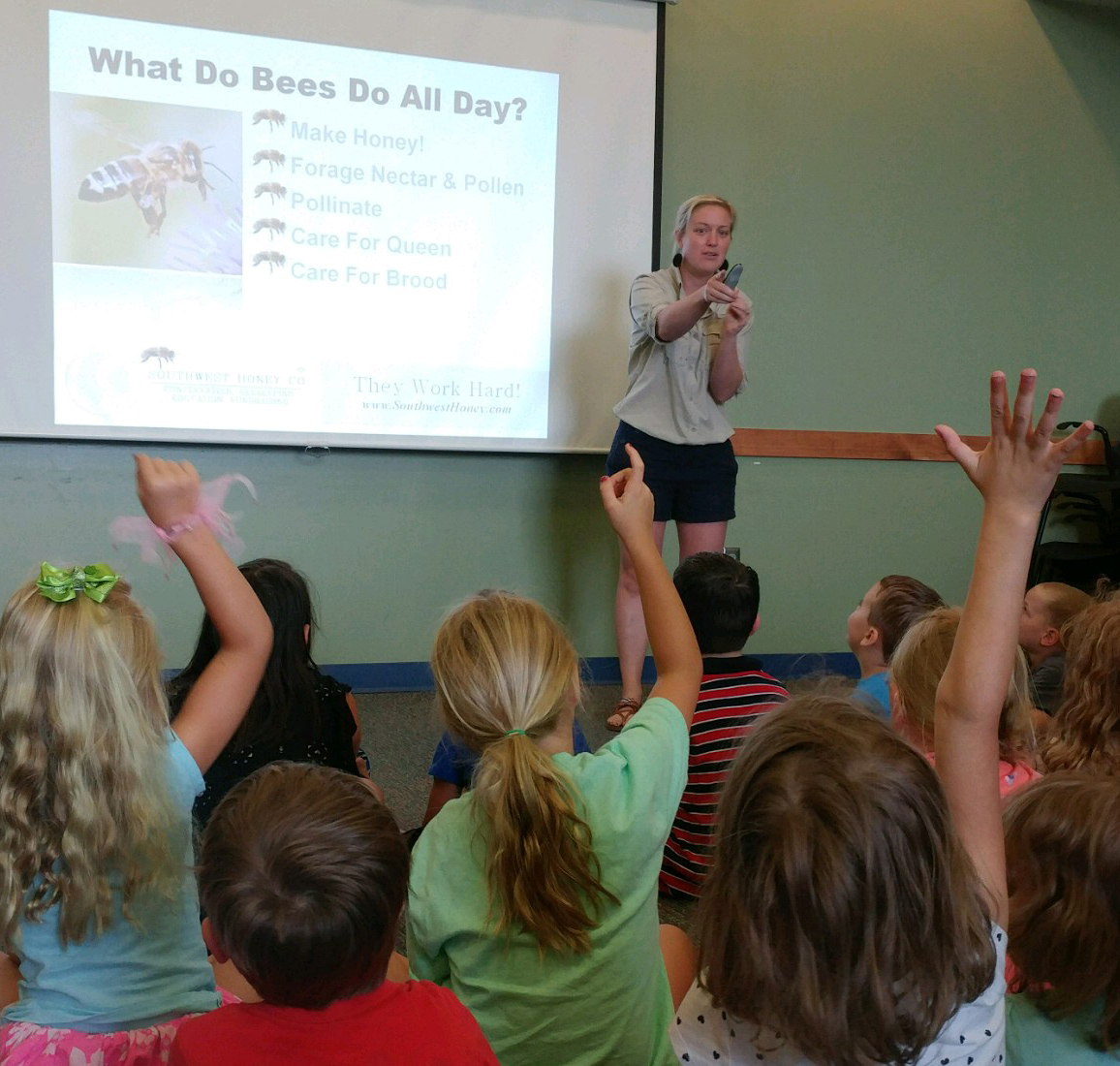
The following are recommendations that Southwest Honey Co. would like to share with SARE:
Due to the findings in this study, we would encourage SARE to continue funding projects and programs that find innovative ways to help community members gain access to the resources and materials needed to make changes that positively impact pollinators and local growers. We found that the desire to make changes to enhance pollinator well-being is present in a large segment of the community. There were various road-blocks that prevented average consumers and community members from implementing these changes. Some of these difficulties included financial burdens. This would include funding projects that encourage better access to native plants and organic/local produce, addressing food deserts where people lack access to healthy produce, and finding alternatives to harsh chemicals for lawn care.
Education is the root to change. It is important to continue funding grants that will provide continuing education and outreach to promote awareness and encourage changes that will favorably impact pollinators. Awareness is key, and we must continue to educate our communities if we want to see true change.
